
1
How to Facilitate Wellbriety
Training Institute Programs
White Bison, Inc./Wellbriety Training Institute Visions
About White Bison
White Bison, Inc., is an American
Indian non-profit charitable organization
operating under the provisions of 501(c)3
of the Internal Revenue Code and is based
in Colorado Springs, Colorado. Through
White Bison, it’s Founder and President
Don Coyhis, Mohican Nation, has offered
healing resources to Native America since
1988. White Bison offers sobriety, recovery,
addictions prevention, training and
wellness/Wellbriety learning resources to
the Native American community nationwide.
Many non-Native people also use White
Bison’s healing resource products, attend its
learning circles, and volunteer their services.
The Wellbriety Training
institute Vision
Vision: We are an internationally recognized,
Native American operated training institute
and center of excellence. We provide
culturally based training for professionals
and grass roots activists who work directly
with individuals, families and communities.
The Wellbriety
Movement Vision
A sustainable grass roots Wellbriety
Movement that provides culturally based
healing to the next seven generations of
indigenous people.
Wellbriety teachings
1. Medicine Wheel and 12 Steps-
Men/Women
2. Medicine Wheel and 12 Steps-
Boys/Girls
3. Mending Broken Hearts
4. Mending Broken Hearts- Youth
5. Understanding the Purpose
6. Fathers of Tradition
7. Mothers of Tradition
A Resource Guide
for Facilitators,
Recovery Coaches,
and Firestarters
“The Elders have told us
that we have entered the
“Coming Together Time” in which a
great healing can occur among
individuals, families,
communities and nations.”
Table of Contents
Visions P.1
Implementation P.2
FAQ's P.3
Reminders
P.4-5
Essential Processes P.6-9
Mindmap
P.10
Fidleity
P.11
Four Laws of changeP.12
talking circles
P.13
Mindmapping
P.14
Culture is Prevention
P.15-16
The Cylcle of Life
P.17
Foundations
P.18
Our Youth
P.19
Healthy Thoughts P.20-22
Notes
P.23
CheckList P.24
Lesson pLaning 25
ONline Registration P.10
Circle REgistration
P.26
Tracking the Circle
P.27
Attendence Roster
P.28
Participant Contact info
P.29
Pre-Program Survey
P.30-31
Post-Program Survey
P.32-33
Program Analysis
P.34-40
Milestones/Resources
P.41-42
Wellbriety Programs P.43
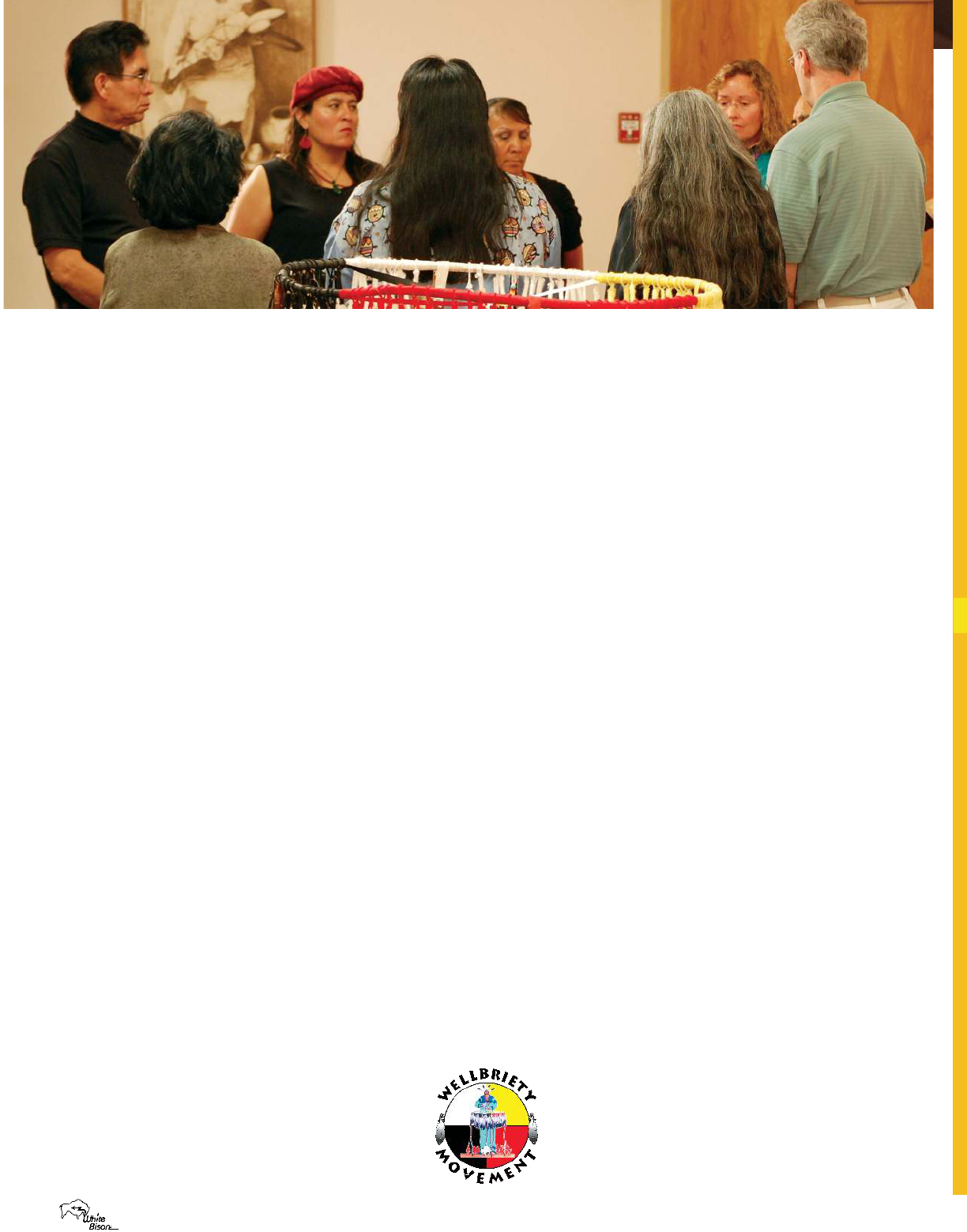
2
Circles of Wellbreity
Once trained, Certified Facilitators conduct Circles
of Wellbriety in their communities. Circles of
Wellbriety address many different recovery issues:
intergenerational trauma, alcoholism, drug addiction,
dual diagnosis, domestic violence, mental health,
etc. Wellbriety can involve individuals, families,
couples, teens and elders. This is why communities
frequently start Circles of Wellbriety for many areas
of dysfunction. Circles of Wellbriety can evolve
into a team committed to bringing healing to their
communities as well as themselves. This creates a
“Healing Forest” where all family and/or community
members can begin the healing process.
Facilitators find other individuals who share similar
experiences and make an agreement to meet on a
regular basis. The meetings are not about “fixing”
other people. They are about creating new thought
patterns, new attitudes, and new feelings about
yourself. The Programs are designed in a series of
modules that foster this process. Participants watch
a video that explains the teachings and how to apply
them. In addition, participants share their insights
and experiences in a talking circle. They also learn
how to mind map their own innate knowledge around
these teachings and then apply that knowledge to their
daily lives and decision making processes. For those
working in Circles of Wellbriety, strong social and
emotional bonds are created that help the participants
to develop trust, autonomy, and other healthy feelings
and thought patterns. These lead to emotional,
mental, physical, and spiritual growth and balance.
Depending on the community, the culture, or the
group, various additional experiences are added.
Drum groups, sweat lodges, singing, learning
traditional dances, learning traditional language, and
listening to local Elders can be part of the Program.
The framework allows for the program to be adapted
to fit the cultural and spiritual preferences of the
participants. Also, materials are designed for men,
women, youth and family members who may have
gender- or age-specific issues.
Continuous communication with Facilitators
and with communities using the programs
provide the nudging and nurturing that keep
volunteers enthusiastic. White Bison instituted
several methods of keeping the communication
pathways open with volunteer facilitators:
• Ongoing assistance and support for new Facilitators
through communication with White Bison and other
members, via Facebook – Wellbriety Technical
Assistance Center.
• White Bison, Inc. website at www.whitebison.org
and Facebook.
• Dedicated staff members reach out to and follow-up
with Facilitators to address their needs and to gather
their feedback; and
• E-mail blasts are sent and published regularly to
keep people informed about outreach efforts, new
resources, and to highlight new training events and
conferences.
Implementing Circles of Wellbriety

3
Register your
Circle
Choose a Name:
After your Circle has met a few
times, it is time to choose a name
for it. Your Circle should choose
a name that means something
significant to them.
Register Your
Circle:
Once you choose a name, then
you can register your group at the
Wellbriety Training Institute website.
Go to www.wellbrietytraining.com,
then click on Wellbriety Circles drop
down menu, then click Wellbriety
Recovery Meetings; there you will
find a link to register your circle.
Or fax the Register Your Circle
document at the back of this
manual.
Materials for
your Circles/
Groups
Once you have attended a training
you will have the knowledge to
facilitate this program in your
community or organization. You
will receive materials to facilitate at
the training, Participant manuals
for your circles/groups can be
purchased through Coyhis
Publishing and Consulting, Inc. at
www.coyhispublishing.com or
1-866-518-5275.
Q: I was trained to facilitate
one of the 12 Trainings
programs. Can I facilitate others
without being certified?
A: Each training is different.
You will need to become
certified to facilitate the specific
program that you want to
implement. Please check the
Wellbriety Training Institute
website for available Trainings
events or call to coordinate one
in your community.
Q: There is so much to learn
in the Training Program; I feel
that I am not ready to facilitate
this program. How can I get
prepared?
A: Remember, your job as
a facilitator is to make the
material available to the people
in your group. You do not have
to memorize the concepts, nor
do you have to present them.
The videos will do that for you.
Q: I am not Native American.
Can I still hold groups/circles?
A: Yes! One thing to keep in
mind, the gatherings and the
circle are not yours. It belongs
to the individuals who attend.
The videos are the teacher.
You are coordinating a safe
environment for people to meet
and share. It is said we don’t put
information/teachings in, we
pull information teachings out.
Q: I really wish the training
had been longer. Why do you
have it for only three days?
A: The purpose of the
facilitator certification
is to provide you with
the skills and knowledge
that you need to facilitate
the program. All of the
trainings are designed to
be implemented over a
number of weeks. When
you begin to facilitate your
own Circle, you will find
that each session, you learn
more and more. The Circle itself
becomes the teacher.
Q: What is the typical length
of each session?
A: Depending on the
curriculum. However, usually
2 hours.
Q: How often do the circles
meet?
A: At least once a week.
However, twice a week is better.
Q: Should my meeting be
gender specific or is co-ed
alright?
A: It is best to have gender
specific circles. However, due
to the nature of the program
and logistics of your community
the circle may need to be co-ed.
One thing to keep in mind for
co-ed circles is the necessary
boundaries for participants and
facilitators. Much is shared
during the circles and close
bonds are created. We are here
to get well.
Q: How can I get questions
answered as I begin
implementing the program?
A: There are several areas
for assistance. Contact the
White Bison office directly,
go to the Facebook site or
page (Wellbriety Technical
Assistance Center “group” and
White Bison, Inc. “page” and
connect with others that have
gone through the program or
e-mail the office at any time for
assistance 1-877-871-1495 and
Q: I am not Native American,
can I still hold groups/circles?
A: Yes! One thing to keep
in mind the gatherings and the
circle are not yours. It belongs
to the individuals who attend.
The videos are the teacher,
you are coordinating a safe
envoirment for people to meet
and share.
Q: I wanted to implement
one of the youth prevention
programs at our local school,
but the principal wanted to
know where the training came
from and who developed it.
What materials can I use to
explain this program?
A: You are able to download
information brochures from the
Wellbriety Training Website
www.wellbrietytraining.com go
to the particular training you
are interested in and click on
“learn more”. You are welcome
to use these to help promote
your program to community
leaders and local organizations.
Q: Why is it important to
register your Circle Groups on
the website?
A: Many people may want
to learn if there is a Circle they
can join in their own community.
Others might want to share ideas
with someone who is actually
facilitating a Circle. Posting the
information allows people to
connect with one another.
FREQUENTLY ASKED QUESTIONS
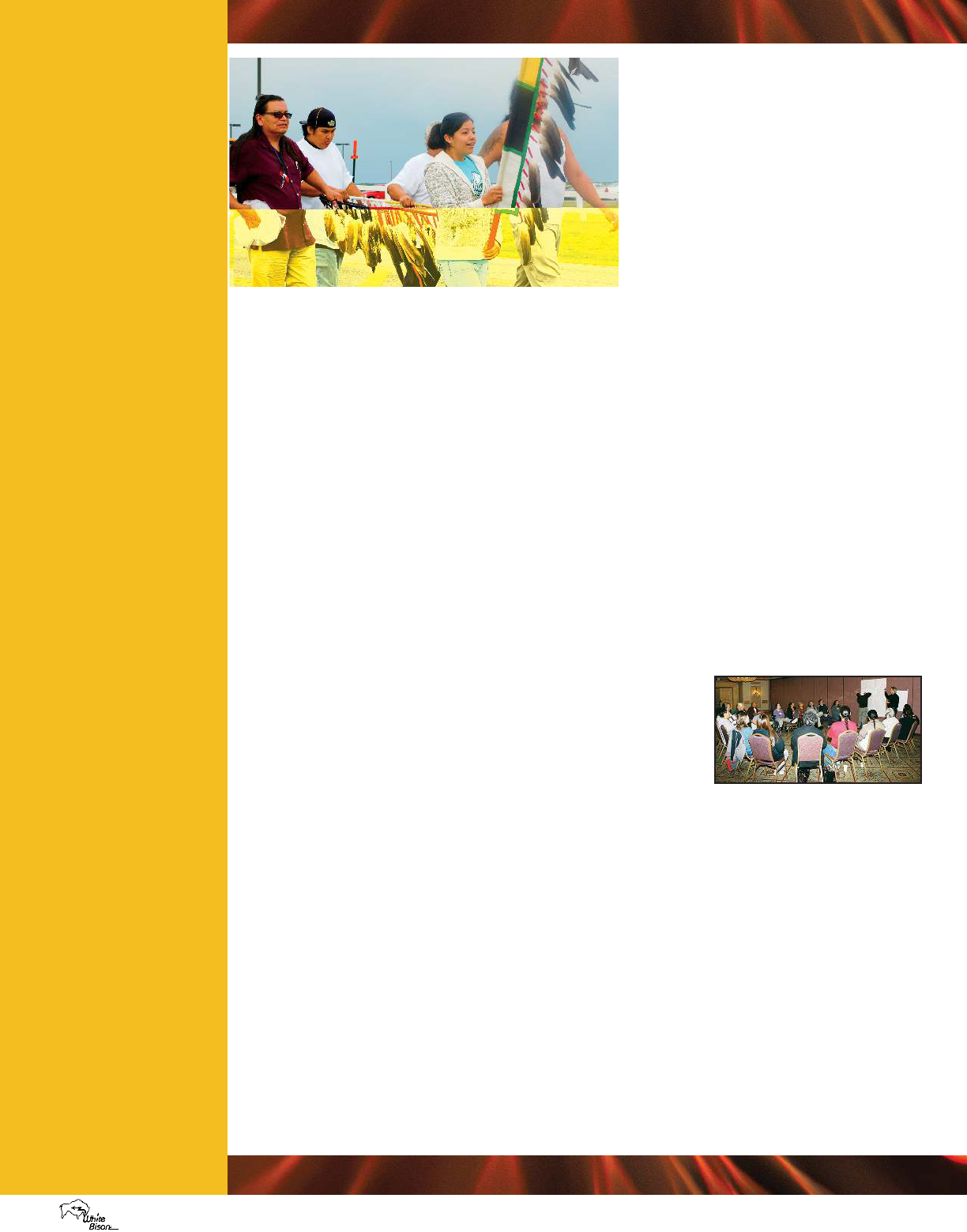
4
Getting
Ready...
• Take the time to think
through and plan how
your meeting will go; use
the themes below to plan
what you will do; they will
help to keep you on track.
• Review each part of the
curriculum: The videos;
facilitator’s manual,
workbook, syllabus,
activity book, posters, etc.
(Each curriculum has a little
different set of curriculum).
The facilitator’s manual
should give you useful
resources and tips for
planning the lessons and
setting up the Circles.
• Review the video tape
for the session and think
through what you could
do to help keep people
involved in the material
on the video and in the
workbook. Remember
that the tapes provide the
teacher. The facilitator
makes sure that everyone
has a workbook and that
they keep focused on
the topics for the day.
• Your goal is to make
sure that people hear
the instructions and
teachings in the video.
Show them how to mind
map the material. Some
of the work will be done
in group, other times
there will be homework.
• For each of the following,
think through what
themes, instruction,
materials, or activities
you need to have in mind.
(Not all of the items will be
relevant for each session).
REMINDERS FROM
YOUR TRAINING
SESSION!
It is our hope that you will
set up Circles in your own
community. This guide should
help you do that. It includes
instructions, resources and
suggestions for implementing
the Wellbriety Training
programs in your community.
It has tips and reminders from
the material that you learned
at your certification training.
There are several pointers to
help you get oriented.
1. All Wellbriety Training
Institute trainings are part of the
Wellbriety Program Community
Curriculum. Each program is
designed to implement a vision
of Wellbriety: a sober life that is
balanced emotionally, mentally,
physically, and spiritually.
In addition, the programs are
designed to address prevention,
treatment, intervention and
recovery. There are programs
for individuals, families, youth,
adult and communities.
2. All White Bison trainings
are spiritually grounded.
People are spiritual beings.
All healing takes place at the
emotional, mental, physical,
and spiritual levels. Traditional
teachings tell us that wellness
is state of being in which the
person is in harmony with
natural law, principles and
values. Opening ceremonies
with a moment set aside for
reflection and prayer are
encouraged.
3. All Wellbriety Training
Institute trainings are
culturally based. This means
that they all share the same
Native American principles,
laws and values. Each program
is based upon the Teachings of
the Medicine Wheel that were
shared with White Bison by
Elders and Clan Mothers of
many different tribes. Cultural
stories, knowledge, practices,
ceremonies, language, music,
dance, and artifacts all play a
part in learning. It is important
that the cultural practices
and traditions of your own
community be included in
the activities, discussions,
and approach of the various
sessions.
4. All Wellbriety Training
Institute trainings reflect the
Healing Forest Model and the
traditional teachings of the
Cycle of Life. The teachings
and principles of these
approaches are very important
for the success of the various
trainings.
5. All White Bison trainings
are video based. This means
that the teacher is the video
(DVD). It is not necessary for
the facilitator to know all of
the teachings at the beginning.
The video provides what is
needed for each of the sessions.
The important part for the
facilitator is to use the videos
as the primary way of sharing
information.
6.All Wellbriety Training
Institute trainings rely on the
concept that education means
to “draw out.” In other words,
each person has knowledge
within himself or herself. The
purpose of the video tapes and
the workbooks or activity books
is to awaken that knowledge.
The process of mind mapping
helps people to organize and
relate information to their
own lives. Thus, learning and
practicing your own mind
mapping skills is very helpful.
The Sacred Hoop was
assembled in a Sweat
Lodge after 100 Eagle
feathers were sent
from all over the
country and canada.
The Elders blessed the Hoop and put in it four gifts:
hope, healing, forgiveness and unity.

5
COMMITMENTS
1. Everything that you say, hear,
or see in the Circle meetings is
kept confidential.
2. Nothing is shared outside
the meeting.
3. These meetings are
designed for learning, sharing
and healing.
4. Each person is to be
responsible for his or her own
choices and behaviors.
5. The Creator is involved in
the Talking Circles and will help
to create new thought patterns,
new attitudes and new feelings
about ourselves.
6. The meetings are voluntary
and self-supporting.
MORE HELP
VIDEO
Be sure you review the
videos included with this
Facilitator’s Manual!
More Teaching Videos
can be found at
http://www.youtube.com/
user/WBDonC
7.All Wellbriety Training
Institute trainings include the
talking circle process in one
form or another. This is an
important resource to use for
helping people (a) get to know
each other; (b) share ideas; (c)
learn to listen; and (d) build
trust among themselves and
within the Circle.
8. The suggested size for
the Circle for these training
materials is between 8 and
15 people. The program
will work with one or two,
but the dynamics of the
talking circles and the mind
mapping processes work more
effectively when there are a
number of people sharing. It
is also important to remember
that talking circles take time.
The more people in the
circle, the more time it takes
to go around the circle in a
meaningful way.
9. There is an opportunity
to share ideas with other
facilitators by visiting
Wellbriety Technical
Assistance Center on Facebook.
In this environment, you are
welcome to post questions,
share experiences and
approaches to implementing
any of the trainings. Also,
if you have questions about
implementing the trainings,
you are welcome to contact
the office.
10. A very helpful resource
is the Red Road to Wellbriety:
In the Native American Way
published by White Bison,
Inc. in 2002. Copies may
be obtained through the
Coyhis Publishing website at
www.coyhispublishing.com.
11. Those who participate
in the White Bison certification
trainings to become facilitators
receive a set of materials
for the curriculum and a
DVD with the curriculum.
Participant manuals for
your circle can be obtained
at Coyhis Publishing website,
www.coyhispublishing.com.
12. The more you work
with the materials and the
videos, the greater your
comfort level will become.
The Sacred Hoop was assembled in a Sweat Lodge
after 100 Eagle feathers were sent from all over the
country. The Elders blessed the Hoop and put in it four
gifts: hope, healing, forgiveness and unity.
The Sacred Hoop traveled four journeys for
25,000 miles between 1999 and 2003, bringing the
message of the Wellbriety Movement.
In 2009, for the Wellbriety Journey for
Forgiveness, the Sacred Hoop Traveled 6800
miles to visit sites of Boarding Schools across the
United States.
The Sacred Hoop
Wellbriety Training is Culturally Based
(Read the story at http://www.whitebison.org/wellbriety-journey/NewsStories.htm).
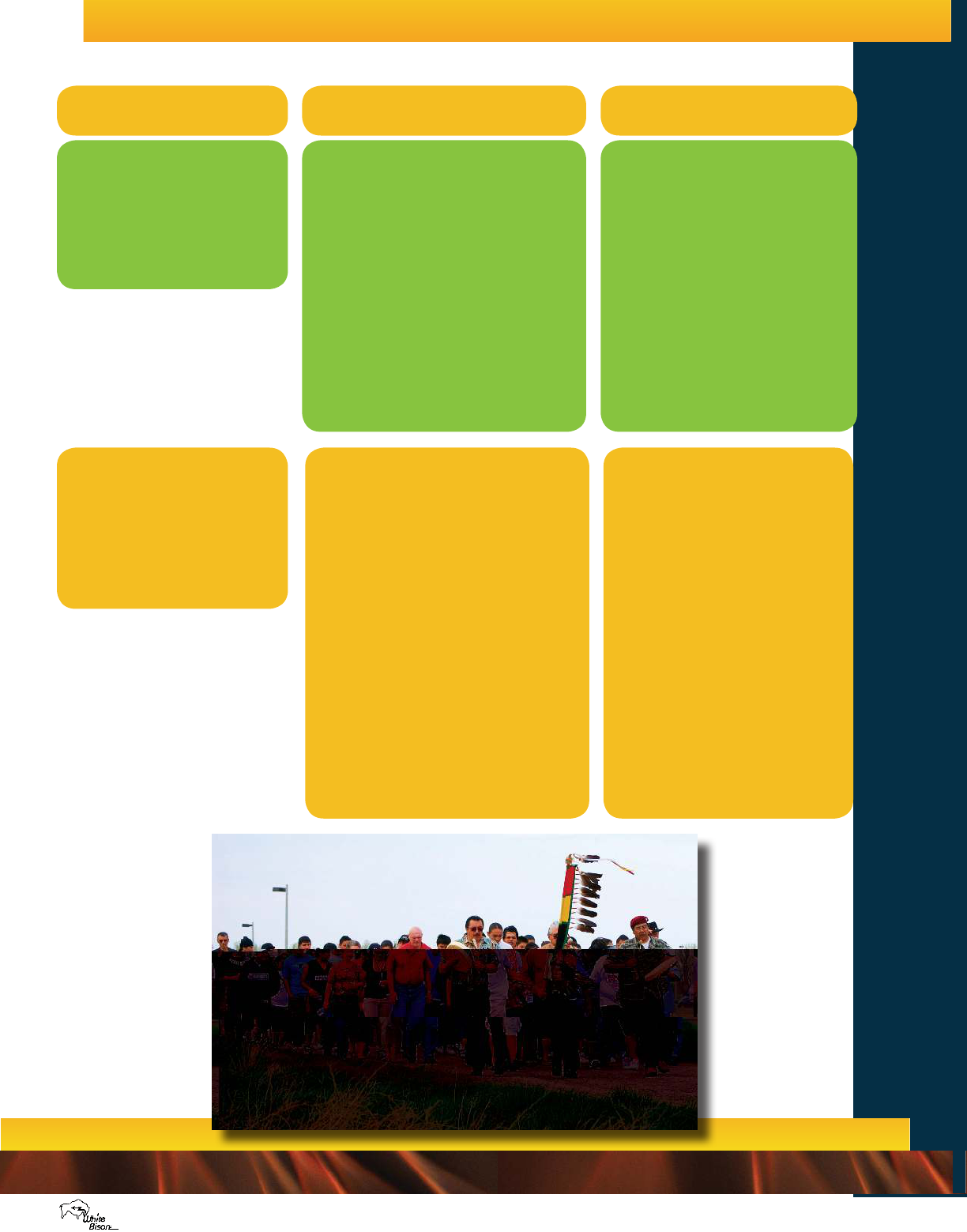
6
Processes or Approach
needed for success
Description
How it is implemented
Mind mapping
Each of the programs includes the
teachings of the Medicine Wheel, the Cycle
of Life Teachings, the Four Laws of Change
and the Healing Forest Model.
These critical teachings form the
foundation of the Wellbriety Movement
programs developed by White Bison. The
teachings have come to us from Elders in
various communities over many years. Our
goal has been to make them accessible and
applicable to people of all ages.
In many traditional cultures these
teachings were passed from one generation
to the next by the Elders. They had many
different names: Teachings of the Good
Mind, Teachings of the Elders, Teachings
of the Medicine Wheel. (Different
designations in different cultures).
Each training program will
have a video presentation about
the teachings and there will also be
sections in the training manuals that
explain these teachings. Participants
are urged to “work with them” in
their own lives as a way to experience
their usefulness and power.
Some of the teachings have been
recorded as sayings in the journals, or
in the books written to accompany the
trainings. Others have been captured
in posters and in power point slides
that accompany the trainings.
It is important for facilitators to
understand the significance of these
teachings and why they need to be
central to the White Bison Wellbriety
programs.
teachings
This is a cooperative learning
experience in which the facilitator draws
information FROM the participants. This is
based upon the teaching that the individual
KNOWS what is important and that with
prompting can find the answers within
himself or herself. The teacher presents
concepts, facts, or questions and the
learners respond with their understanding.
Mind mapping uses this approach which
is very similar to the traditional teaching
methods in which the Elder would ask
questions that would make the learner
think and apply what had been observed.
This is an important learning practice.
Mind mapping is used for learning
and applying many of the teachings
and concepts. It is used also as an
organization tool to capture
information in planning sessions,
for preparing lessons, and for
remembering important points.
Essential Processes and Approaches, Cont.

7
Processes or Approach
needed for success
Description
how it is implemented
Learning traditional
ceremonies, practices
crafts or lifeways
People who have “been there, done
that” have much strength, experience
and wisdom to share with others. Mentors
can be “peers” (i.e. others in recovery,
youth of the same age group) or they can
be older youth helping younger youth,
or caring adults helping youth, or caring
adults helping other adults.
Mentoring also occurs in social support
networks and in mutual support groups.
The mentoring process serves to help
those who are “searching” to find the path.
Those who want to learn how to work their
way through challenges will find many
opportunities through the mentoring
relationship.
Wellbriety programs are designed
to provide mutual support. All of the
programs were designed by Native
Americans in the recovery community,
for other Native Americans. Youth and
adult programs encourage the
development of “circles.”
The Circle itself is a powerful medium
for healing and for change. Learning
within a circle of peers can accelerate
healing and create a connectedness that,
in itself, helps people overcome barriers.
Facilitators are encouraged to seat people
in a circle so they can see each other.
Sharing and mentoring are very important
for the healing process. Being connected
to a community and being responsible
for others in a healthy way, brings about
personal growth and builds character.
Mentoring by peers
or by caring adults
Learning about local traditional
cultural and spiritual practices is
an important way for a person to “get
connected” to his or her culture. The
Wellbriety programs encourage facilitators
to work with local elders to incorporate
some of the traditional ceremonies and
spiritual practices (as well as those
connected to the local churches).
For many of the youth programs,
traditional crafts, such as beading, making
cradle boards, flutes, and powwow regalia
are encouraged. It is intended that these
be taught in the traditional ways, so that
the youth will understand the meaning
and the "ceremony" that goes into the
traditional arts and crafts.
Facilitators are encouraged to learn
how to conduct opening ceremonies.
Many tribes also have ceremonies for
age related rites of passage, for marriage,
for healing, for making relatives, and
for a variety of personal, family, and
community issues. Elders can also
provide cultural teachings and knowledge
about the traditional ways of living. It
is important to learn what these are in
the local community. Churches can be
another source of spiritual practices that
can help with healing
Many of the cultural traditions and
practices can be woven into the lesson
plans. Some of the practices, depending
upon local traditions, might include
sweat lodge, pipe ceremony, drumming,
or dance. Traditional sports can also be
appropriate, especially team sports. Local
cultural traditions can be very helpful in
the healing process. They also help youth
and adults reconnect to their cultural
heritage.
Essential Processes and Approaches

8
Processes or Approach
needed for success
description
how it is implemented
Journaling
Giving back to your own community
is an important part of belonging.
Healing occurs at the individual, family,
community, and nation levels. Community
involvement or learning through service to
others, is a way for those in recovery and
for youth to develop confidence, leadership
skills, and most importantly, to develop a
sense of connectedness to others. Those
who reach out to others find out that they
can learn from other people and that they
have something to share with other people.
For those in recovery and for youth, service
learning and community involvement can
be a stepping stone to gainful employment.
Community involvement and service
learning are integrated throughout the
Wellbriety programs.
Training of community members
as facilitators assures that they will
provide the teachings to others in their
community. Adults in recovery, and
youth who participate in the various
programs learn how to set goals,
plan and implement events, group
activities, coalitions, and community
change efforts.
Community
Involvement
( Service
Learning)
Writing down what you are thinking,
writing down personal responses to
what is seen, heard, or experienced and
then reading them back to yourself over
time helps to (a) learn how you react to
situations;(b) learn to read the "patterns"
in your thought processes;(c) practice
expressing feelings and describing specific
experiences; and (d) begin to identify what
to change in order to have a more healthy
life.
In the youth and adult programs,
"journaling" can take place using
writing, mind mapping, or drawing,
depending upon the exercises and the
age of the participant. Journal notes
can be used as prompts in talking
circles, or they can be private. They
can be used by participants who
work with a partner, or in a small
group, to sort out a problem and find
alternatives to a pattern of thinking
and reacting.
Journaling can be used to help youth
"draw out" their own thoughts and
understanding about specific issues.
Working through each of the 12 Steps
also uses a mind mapping journaling
process.
Essential Processes and Approaches, Cont.
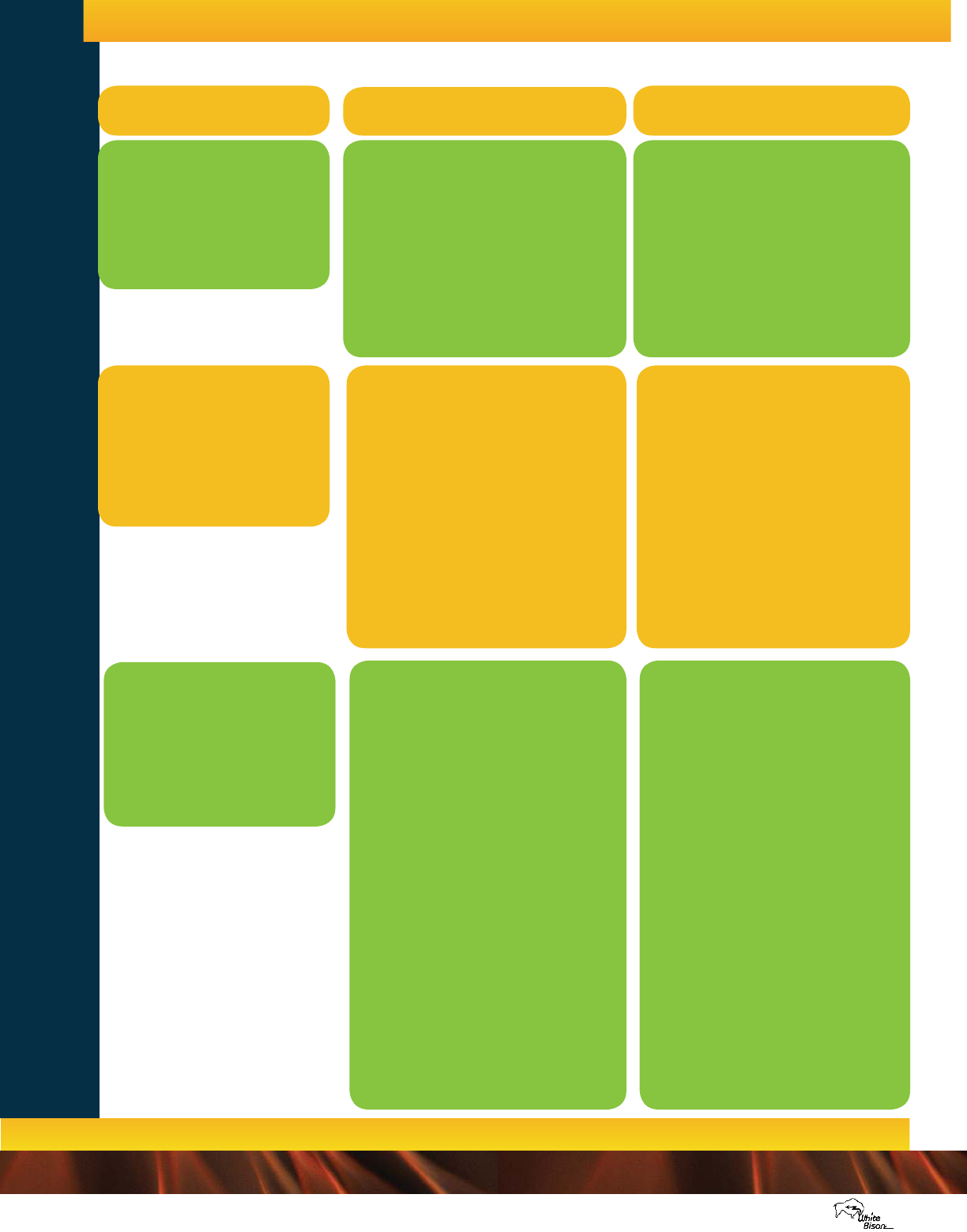
9
Processes or Approach
needed for success
Description
How it is implemented
Opening ceremony
The major teachings and instructions
for each step of the learning process are
contained in the DVD'S for each of the
Wellbriety Training Institutes Training
Program.
Some of the videos are designed as
instructional resources for facilitators.
The videos (DVDs) for these
programs serve as the “teacher.” Use
them as described in the curriculum
manual. Each time a video is shown, it
should be followed by a talking circle
in which participants describe their
thoughts, feelings and experience with
the content of the video. Participants
should also be encouraged to write about
these experiences in their journaling
exercises.
Videos/DVDs
Learning and particpatin in cultural/
spiritual practices; learning about prayer.
The agenda for each session begins
with the opening ceremony. In the
beginning, the facilitator would invite and
Elder or Clan Mother to explain how the
ceremonies work. Some circles may also
choose to use those spiritual practices
associated with their preferred faith.
Each time the ceremony is performed
it is explained. After a time, youth and
adults will be able to conduct the opening
ceremony themselves.
Talking circles
”The circle provides healing.” Talking
Circles are traditional in Native American
communities. They have been used for
centuries as a learning format a decision
making process, conflict management
process, and general healing process.
There are specific rules for participating
in the circle and for initiating the circle.
One of the rules is that people cannot be
interrupted; only one person speaks at
a time. This particular rule encourages
validation of the individual and helps
him or her to realize that the thoughts,
feelings, and opinions of others are to
be valued and acknowledged. For those
who come from dysfunctional families
(“Don’t trust. Don’t Talk. Don’t Feel.”)
This knowledge and experience can be
healing in itself.
How to conduct talking circles
can be found at:
http://youtu.be/3RdIX7UM4ks
Talking Circles are a part of almost every
session in every program. Facilitators are
taught how to implement them and they,
in turn, teach the participants the rules
of the Talking Circle. Talking Circles are
used to debrief the videos, to explore
concepts, teachings, issues, feelings,
and experiences. Participants learn to
express themselves emotionally and
mentally. Spiritually, participants learn
to experience the healing that being a
part of a community (i.e. the circle)
brings.
The mutual support networks (webs)
that are formed are often lasting.
Parents, families, youth, couples,
co-workers, community agency workers
are encouraged to apply talking circles
as a resource for solving problems,
making decisions, addressing specific
issues, manage conflict, sort out feelings,
develop solutions, ideas, and uncover
important values.
Essential Processes and Approaches
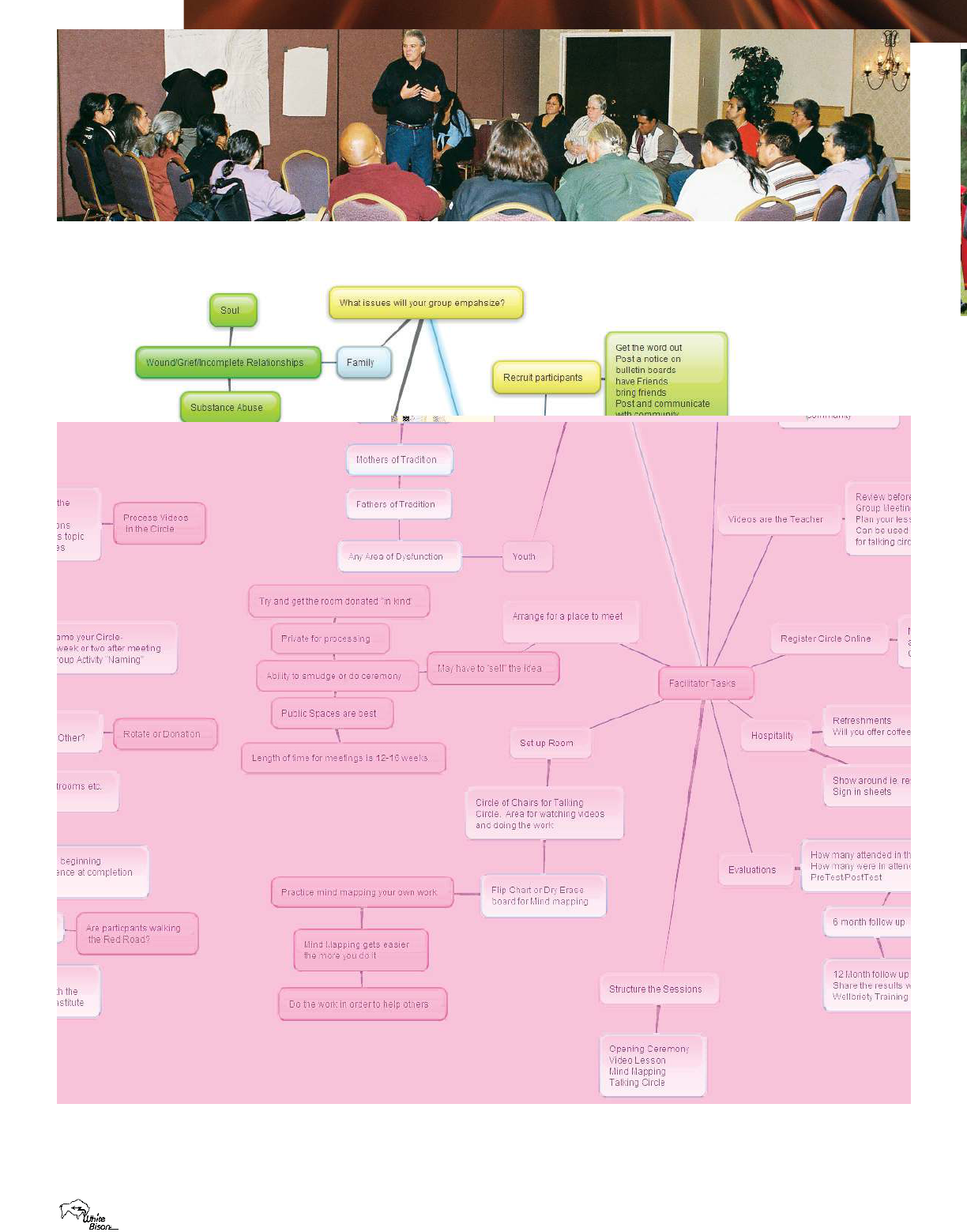
10
(Read the story at http://www.whitebison.org/wellbriety-journey/NewsStories.htm).
MIND MAP WILL GO HERE
Mind map for starting cirlces

11
Website
Visit the White
Bison, Inc.
website for
the Wellbriety
Institute training
schedules,
conference
dates, discussion
board, Technical
Assistance
Center,access
to the Facebook
and to
Wellbriety!
www.whitebison.org
www.wellbrietytraining.com
Visit us on
Facebook and
Twitter
@Wellbriety!
Fidelity
(mAKING SURE THE PROGRAM IS SUCCESSFUL)
Some people have asked, “How can I be sure
that implementing this program will work?”
Success in any effort requires that you follow
the “Natural Order” of the task. Determining
whether a program works or not depends upon
implementing it the way that it was intended.
One of the most important things to remember
about Wellbriety Training programs is that
they each have a “natural order.” This means
that certain topics are scheduled before other
topics. In the Medicine Wheel and 12 Steps it
is important to complete Step 1 through Step
12. Some teachings and concepts have to be
understood before a person can get the most
out of what comes later. In the youth and
family programs there is also a natural order:
Individual, Family, Community, and Nation.
One must learn about one’s self before trying
to understand the family, or the community,
or the nation.
Because we are trying to determine the
effectiveness of the White Bison programs,
it is important that they are implemented as
they were intended. The main processes used
to develop understanding and to learn how to
implement the teachings include the videos,
talking circles, and mind mapping. These
teaching processes were used by our ancestors
to share the principles, laws, and values that
create the “Good Life.”
In the youth programs, the key elements
are the teachings, talking circles, mentoring,
service learning, and character development.
Youth also need a great deal of “hands on”
and “interaction” in order to learn. To help
the youth get the most out of these videos, it
is important to talk to them about how the
Elders passed along teachings in the days of
our ancestors. Elders spoke, youth listened.
After the video is completed, hold a talking
circle to have the youth share their experience,
thoughts, and feelings about what was in the
video. This time of processing the information
is essential for the learning to be complete.
The charts on the previous pages provide the
context and the processes that are essential for
the White Bison programs to work effectively.
Ensuring that they are followed will ensure
that the program that is implemented retains
“fidelity” with the way that it was intended to
be implemented.
FIDELITY

12
THE FOUR LAWS OF CHANGE
The Elders have told us that
in order for any change to be
successful, there are four laws that
must be followed. Understanding
these Laws can help us succeed in
our Journey to Wellbriety.
#1
Change is from Within
Remember to tell the people they must change
themselves from within. Making changes must come
from an internal desire to make a difference in our
lives. We must make a conscious effort to change
our intent, our choices, our behaviors, and even
our feelings and assumptions about who we are as
spouses, parents and family members.
Becoming a healthy person requires a commitment
from within ourselves. Becoming a healthy family or
community also requires a commitment
Teaching: Inside of every human being is the
innate knowledge of your own well-being.
Teaching: All permanent and lasting change
starts on the inside, then works its way out.
Teaching: To ensure permanent change for a
person, it must happen on the inside first.
#2 In order for development to
occur, it must be preceded by a vision.
Once a person/family starts to grow, they need to
create a vision/pictures that they will use to develop
themselves. It is important to develop a vision of the
role that a healthy family plays and the values that
a healthy person displays in his or her relationships
with family and community members. The Wellbriety
Movement helps each person take the steps to create
a better life for self, family and community.
Teaching: You move toward and become like
that which you think about. If you move toward and
become like that which you think about, then it is
important to think about what you are thinking about.
Teaching: The law of vision ensures that your
future will not be an accident. Once you develop
the vision, the spiritual world will then give you a
development plan and guide your actions to move
towards the vision you just created.The Wellbriety
Movement Vision
#3 A Great Learning must take
place
Everyone needs to be a part of the change in order
for a change to occur.
Teaching: In order for change to occur, the
whole cycle must be involved in the change: baby,
youth, adult, elder; individual, family, community,
nation. If children are to change, then the parent,
relatives, family, elders must be changing themselves
also.
#4 You must create a Healing Forest
• The healing forest model is illustrated below.
The idea is that a forest, like a community, is
only as healthy as its roots and environment.
Unless individuals, families and communities are
provided with a means of overcoming the impact
of the unhealthy, dysfunctional root system (anger,
guilt, shame and fear), they will find themselves
participating in unhealthy behaviors.
• Traditional cultural practices (ceremonies,
teachings of the elders, understanding of one’s place
on the Mother Earth and understanding of the
meaning of spiritual and cultural practices) can
enable individuals to make positive and healthy
choices about their lives.
• It is our role as parents and grandparents,
community leaders and Elders to create a healing
forest for our children grounded in love, respect,
forgiveness and acceptance.
• If the community is to change, the new change
must occur at the root level. Values, culture,
spirituality, teachings, and ethics must replace the
anger, guilt, shame and fear.

13
Set-up Circle
Arrange Chairs in a
circle
Identify an item that can
be used as a talking tool
(i.e. feather, stone, stick)
Open the Talking Circle
by asking for guidance
from the Creator
(using your own
spiritual tradition).
Review the rules for the
Talking Circle:
Everything said in the
talking circle stays in the
talking circle.
Everything heard in the
talking circle stays in the
talking circle.
Everything seen in the
talking circle stays in the
talking circle.
Only one person speaks
at a time. (i.e. the person
holding the feather)
Show respect to others
by not interrupting.
Listen very carefully
to what each person is
saying.
Speak from your own
strengths, experience
and hope.
Go around the circle
clockwise
(If it is your community’s
custom to go
counter clockwise, then
use that approach)
(Read the story at http://www.whitebison.org/wellbriety-journey/NewsStories.htm).
The talking circle is a way
of communicating that is
designed to have people sit in a
circle. The universe is designed
to function in a circle. The
planets travel in a circle, the
moon travels around the earth,
the seasons are circles, the
cycle of life--baby, youth, adult,
Elder-is a circle; and electrons
travel in a circle. Energy also
travels in a circle. The universe
is interconnected. When
people sit in a circle, they will
naturally connect with one
another. It is difficult to
connect when sitting in rows
because energy does not travel
in straight lines.
Where did the
Talking Circle
come from?
In the old days, Native
American people lived their
entire lives in harmony with
the universe. Their teepees
were round, the villages were
constructed in a circle and the
ceremonies were conducted in
a circle. Circles were a way
of life. People lived their lives
and conducted themselves
according to the principles,
laws and values which were
given by the Creator. One
of these values was to be
respectful. Whenever people
sat down to talk, they would
form a circle and would talk
one at a time. Everyone would
have his or her say. People
would not interrupt and people
would not be passed over if
they wanted to speak.
When is the
Talking Circle
used?
Whenever you desire to have
people talk from their hearts
as well as from their heads.
There is a saying: “The whole
is greater than the sum of its
parts.” Having the group sit
in a circle and take the time to
connect with each other, will
connect each person’s mind to
form “one great mind.” This
connecting of the minds will
create solutions and ideas that
will be far more useful than
the results of only one person
thinking alone.
How does the
Talking Circle
work?
1. Have people sit in a circle.
2. The circle has four
directions: east, south,
west, north. The facilitator
should sit in the east.
3. Each time the circle meets,
the facilitator needs to
explain the principles
for the talking circle:
Principles
• The circle is sacred. It
was given to us by the
Creator. This is one of
Creators many gifts which
we are to use according
to Creator's instructions.
• The circle represents life
and everything that is
good. The circle represents
harmony and balance.
It is to be respected.
• Please respect the
following guidelines: The
circle is sacred. “ Who you
see here, what you hear
here, when you leave
here, let it stay here.”
1. Arrange chairs in a circle.
2. Identify an item that can
be used as a talking tool
(i.e. feather, stone, stick)
3. Open the Talking Circle by
asking for guidance from
the Creator (using your
own spiritual tradition).
4. Review the rules for
the Talking Circle:
Everything said in the talking
circle stays in the talking circle.
Everything heard in the talking
circle stays in the talking circle.
Everything seen in the talking
circle stays in the talking circle.
Only one person speaks at a
time. (i.e. the person holding
the talking tool)
♦Show respect to others by
not interrupting.
♦Listen very carefully to what
each person is saying.
♦Speak from your own
strengths, experience and hope.
♦Go around the circle
clockwise (If it is your
community’s custom to go
counter clockwise, then use
that approach)
What happens
as a result of the
circle?
Because the circle is in
harmony with the universe,
there are certain gifts which
will be given to the group,
providing that the guidelines
are followed. The first gift will
be the feeling of belonging
and the second gift will be the
sense of trust. It is these two
gifts that enable the group
(and the individual) to grow in
effectiveness.
Having individuals sit in a
circle each time the group
meets will help them tap into
their innate knowledge of what
is right and what is healthy.
The Talking Circle

14
Mind Mapping
Building Mind Maps
Mind maps are designed to draw out innate knowledge
from the individual or the group. The way that the
mind mapping process is approached can make the
difference between gathering meaningful information
or superficial words. Building a mind map is a process
that has several steps. These steps can be described as:
Creating the Picture, Identifying Trigger Words, Going
to the Next Level, and Reflecting on the Whole.
Creating the Picture
Mind maps begin with a picture. This picture is best
drawn--even if the drawing looks pretty “primitive!”
Stick figures, symbols or shapes can be used. The best
pictures come from the person or the group. The way
to get to the picture is to ask the following questions:
• What images do you see when we talk about this
idea?
• What symbols do you know of that could represent
this idea?
• What are you SEEING in your mind when we talk
about this idea?
The goal is to try to get to the “essence” of the idea; the
bottom line of what it means. When people first begin
using mind maps, there is the tendency to want to put
a word in the center. Pictures access the creative and
emotion focused part of the brain. Words access the
logical part of the brain, so it is better if pictures are
used; also pictures can express more in a small space
than words can. It is also a good idea to use colored
marking pens -- the colors and the pictures will bring
forth emotional responses more readily than pencil and
words. (In this curriculum, many of the mind maps
have words in the center of the circle. These words are
only there to provide a theme. The participants should
draw a picture or cut out a picture to put in the center
of the mind map. They can just paste it on top of the
circle).” You are always encouraged to build your own
mind maps with your own pictures in the center.
Trigger Words
Once the picture is developed and drawn (or pasted
on the circle), then it is time to begin identifying
trigger words. A trigger word is a word that comes as
an immediate response to the picture. “What do you
think of when you look at this picture and think about
this concept?” These are generally random and may be
different for each person. It would help to put several
lines around the picture in the shape of spokes on a
wheel. The posters vary. The purpose of the line is to
get the brain to respond by wanting to “fill in the blank.”
(One of the principles of the way the brain works is that
it is always trying to complete things. It doesn’t like
blank spaces, lack of closure or missing information.)
The actual number of lines will depend on how many
trigger words you and your group identify. The phrase
“anything else” and adding another blank line might
draw out a few more responses if there ideas seem to
be missing from the trigger words. Trigger words, are
just words, not sentences. It is best to use only one
word on each line; however, sometimes the word is
accompanied by defining term. Other clarifiers can be
place on new branches that extend from the word.
Going to the next level
After constructing the trigger words around the picture,
then choose one to start with and expand it using a
phrase like: “What does this make you think of?” “What
about this word?” “What is it related to?” Going to the
next level and then to the next level after that is very
important. The first trigger words may be superficial--
things that everyone says. When you start going down
deeper and deeper, you get to the REAL issues and
the REAL words that the person or group thinks is
important. Continuing to probe with “What else?” A
blank line is a good way to keep the group moving on
the issue.
In the example above, the bold words are the “trigger
words.” The branches extending from those words are the
words that are the answers to “so what about this?”. The
could be verbs, nouns, or adjectives. They can be written in
different colors. They could be pictures too. For instance
Happy Face or a Sad Face could be substituted for “happy/
not happy.” Not only are the words or picture chosen here,
but there is freedom for discussion and description of what
various people mean. There is no hurry. Remember to ask
at each level: “What about this?”
Reflecting on the whole
Once the group has exhausted its “drawing out”
process, it is time to look at the big picture. Look for
relationships, patterns, or themes. Use colored markers
to draw arrows or circles around things. Get the
participants to summarize what they have learned, what
teachings are “hidden”in the themes and words.

15
CULTURE IS PREVENTION
Culture is Prevention
Our ability to see the issues of the children can be
clouded by our own experiences growing up in an
family with alcohol or drug addiction.
Often adults who grew up in families with these
issues have unacknowledged anger, guilt, shame, and
fear. These responses have become internalized to
the extent that they filter every interaction and every
decision in one’s life.
Experiences of neglect, emotional, physical, even
sexual abuse, the lack of support, the need to “be the
adult” the need to take care of other siblings because
parents cannot, economic and spiritual poverty ....
all of these issues become “normal” to children who
grow up in a household ruled by alcohol or drugs.
In today’s environment, meth adds another layer of
dysfunction. Individuals who use meth can become
excessively violent; their hallucinations can result
in death for themselves and those around them. The
chemicals used to manufacture meth can have long
lasting physical effects on children.
For children life in a family affected by alcohol or
drugs, the experiences can leave lasting scars and
they can shape a young person’s world view, making
the dysfunctional behaviors appear to be normal. As
we become aware of the characteristics of Children
of Alcoholics and how those characteristics affect
us as adults, we can begin to see the importance
of healing ourselves first and then helping those
children in our care to learn new coping skills
and new ways of understanding themselves.
Flowing through the entire Families of Tradition
curriculum is the principle that Culture is Prevention.
Living within the context of a rich culture and
developing an understanding of the Natural
Principles, Laws and Values that our ancestors knew,
create pathways to prevention.
• People are either in harmony or out of harmony
with the principles, laws, and values. Living in
harmony is called culture. It is from understanding
and living in harmony with these principles, laws and
values that individuals develop the “Good Mind.”
• The natural state of the human being is to trust and
they only learn mistrust as a result of dysfunctional
environments and fear-based behavior on the part of
those who are supposed to care for them.
• The eight feelings and eight though patterns are
the source of positive (functional) behaviors.
• Changes must happen in the spiritual (unseen)
world before they can be observed in the behavioral
(seen) world.
• Families must learn to look within to develop
healthy boundaries and thought patterns.
• Looking beyond one’s self by helping others and
serving the Creator are pathways to creating meaning
in one’s life; cultural and spiritual traditions provide
the structure and the process for finding these
pathways.
• The more individuals learn to understand and
participate in traditional cultural and spiritual values
and practices, the more likely they will be able to
develop the feeling of meaningfulness that will guide
them in making healthy choices.
• Character defects are created as a result of a fear
based system. Personal assets develop as a result of
a love based system. By adding healthy principles,
laws, and values to the “soil” of the culture, the fear
based system will be replaced by a system of healthy
values: respect, harmony, unity, hope, and love.
Culture is reflected in the
behavior of individuals and
communities.
The chart that follows lists a variety of actions
that demonstrate commitment to the principle that
Culture is Prevention.

16
Culture is Prevention - Themes and Issues
Individual Family Community Nation
Emotional
Development of a
sense of trust;
Development of the
eight feelings for
healthy
living;
Self-identity with
Native American
Culture
Development of a
sense of trust, security,
and safety
Importance of family
network of relationships
(extended family);
Knowledge of clan
system
Creating community
systems and
leadership
for ensuring safety
and wellbeing;
Promoting
celebrations and
ceremonies
that create
interconnectedness
Identification of the nation
with the environment and
what that means as a "people"-
-enhancing the
sense of identity as a nation--
what it means to "be"
Physical
Development of healthy
behaviors and lifestyles
Learning traditional
practices and ways of
doing things
(ceremonies, crafts,
physical strength and
conditioning)
Transmitting the
traditional practices
such as ceremonies,
drumming, dancing,
singing, etc. from one
generation to another;
Including Elders as a
part of family problem
solving, celebrations,
and decisions. Making
sure that the voices of
the children are heard.
Healthy relationship
to environment;
attention to physical
surroundings;
Creating systems
that care for the land
and create a sense
of appreciation for
surrounding; Create
systems that link and
coordinate
community services
Creation of policies,
practices, cultural
centers, methods of
transmitting culture
using traditional and
technological means.
Establishing local
policies and practices
that demonstrate
respect for the Earth
and environment.
Mental
Ability to set clear
boundaries;
Knowledge of and
understanding of
traditional teachings;
Ability to apply them in
problem solving and
decision making in
everyday life.
Communicating
knowledge of language,
traditions, and cultural
practices; Development
of an understanding of
the role that language
plays in the Natural
Order
Developing
community
vision that defines
practices,
expectations,
and actions based on
traditional values that
support healthy
thinking
and relationships
Providing guidance and
systems for thinking
about and transmitting
and clarifying traditions,
ceremonies, cultural
and spiritual teachings
from one generation to
the next; Developing
strategies for
communicating with
other nations.
Spiritual
Belief in the Natural
Order (natural laws,
principles and values)
Participation in
cultural
practices and
ceremonies.
Application of
language, stories,
spiritual and cultural
traditions to one's life;
Applying principles,
laws and values of the
Natural Order; Living
within the values of the
community (i.e.
courage, humility,
interconnectedness)
Provide leadership in
preserving and
redefining spiritual
and
cultural traditions,
language, stories,
songs, ceremonies,
and
the Natural Order for
healthy living
Providing guidance and
systems for thinking
about and transmitting
and clarifying traditions,
ceremonies, cultural
and spiritual teachings
from one generation to
the next; Developing
strategies for
communicating with
other nations.
Youtube Link: https://www.youtube.com/watch?v=mMETGOUtq24
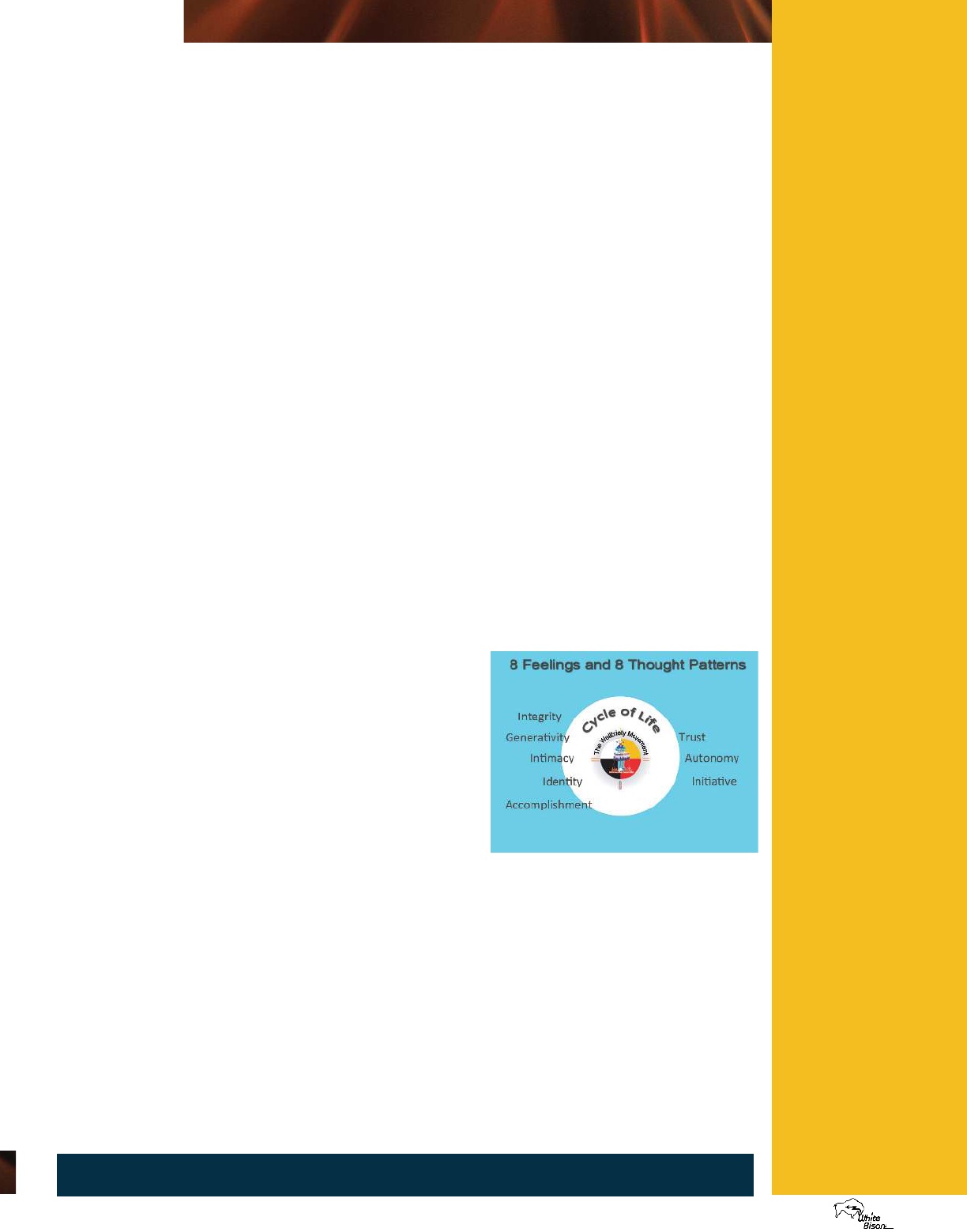
17
The Cycle of Life Teachings: Eight
Feelings and Eight Thought Patterns
The Healthy Path from Baby, To
Youth, To Adult, To Elder
Eight Feelings and
Eight thought patterns
The Cycle of Life teachings explain the development
of eight feelings and eight thought patterns. In
order for a person to develop in a healthy way, these
eight feelings and thought patterns must develop
sequentially. For many people, important stages of
development were disrupted or are incomplete due
to traumatic childhood experiences, illness, or as
the result of alcoholism or substance abuse. The list
below shows what individuals should have developed
by the time they become adults. But many people
who were raised in families with alcohol or drug
dependence and dysfunction there was another set
of experiences: “Don’t Talk! Don’t Trust! Don’t Feel!”
All White Bison trainings include the Cycle of Life
teachings.
Cycle of Life teachings
• Trust (feeling of security)
• Independence (feeling of autonomy)
• Initiative (feeling of being able to take a risk)
• Accomplishment (being good at something,
being good for something)
• Identity (feeling of knowing who I am)
• Intimacy (feeling that I belong somewhere,
connectedness)
• Generativity (feeling of being able to give back
what I have learned)
• Integrity (Feeling of confidence -- What would
you do when no one is watching?)
the cycle of life
“The human
being runs HIS
OR HER ENTIRE
LIFE BASED UPON
EIGHT THOUGHT
PATTERNS.”
Tips to
help start
a circle in
your family
Participate
Because this is a process
that involves all the family
members, it is important that
everyone participates
in setting up and designing
how the Family Talking Circle
night
will occur.
Specific Time:
Select a specific night/time
of the week that is designated
as Family Talking Circle time.
Everyone is
required to be there--especially
Mom and Dad. This might
mean some negotiation at
work.
use suggestions
Position a basket or a jar in the
room and some paper. Each
person in the family can write
down
dinner suggestions for Talking
Circle night. Each night one
of the suggestions would be
selected as the meal for the
event. Let people suggest
“interesting foods” --- banana
split, chocolate chip cookies,
hamburgers, pizza. If the
talking circle occurs at dinner
time, there is no reason why
a 4 year old can’t request ice
cream for the night’s ‘dinner!’
The goal is to make this a fun
occasion and to give each
person the opportunity to “be
in charge.” (Mom can put
vegetables and salad on her
suggestion slip!)
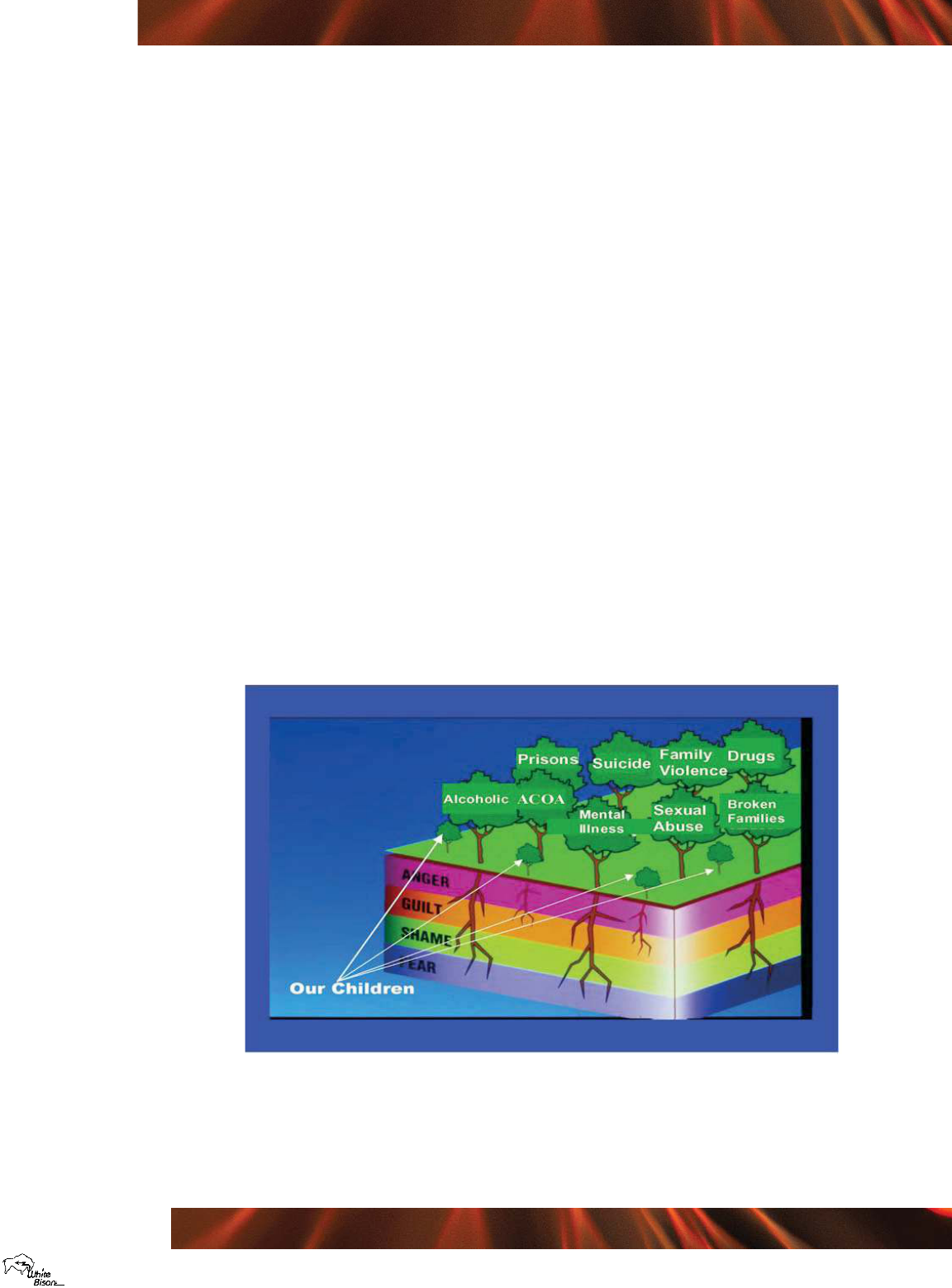
18
OUR YOUTH
We must change the way we think
and feel to change the way our
children grow.
The forest in the picture below represents the
communities in which we live. Many of the adults
are unhealthy. Some are alcoholics, some have
drug abuse problems, some abuse their children or
their spouse, some have been in prison. Some have
grown up in alcoholic families themselves and have
continued to teach their children what they learned
themselves as children. Some of our adults experience
depression and some have mental illnesses. Many
come from broken families, and many experience
the break up of their current family. Beneath this
community of adult “trees” are the children trees that
are trying to develop into healthy adults themselves.
Unfortunately, the nutrients in the culture in which
they are all growing are contaminated with anger,
guilt, shame and fear.
It is the goal of this program to help Native
Americans who work with children to learn new ways
of thinking and feeling about themselves and to learn
new ways of helping their children develop. On the
next couple of pages, the trees represent the issues
that children deal with in the community at different
ages. The video on the Cycle of Life provides an
in-depth overview of the needs and developmental
issues for each of the 8 feelings and thought patterns
that are described. As a mentor, teacher, guardian or
care provider you can help the children in your care
to master the healthy thought patterns and feelings
that will prepare them to be healthy human beings.
The healthy forest on page 20 illustrates how
the forest (community) will look when adults and
children have the ability to choose healthy thoughts
and feelings. This comes about through a spiritual
process of prayer, ceremony, learning traditional
values, cultural ways and passing those on to our
children.
The material on the pages that follow provide
information that is vital in the development of
healthy Native American parents and children. The
Four Laws of Change, the chart on previous pages
explain what has to happen in order for things to
change and illustrates healthy development and
unhealthy development of children. The Forest
pictures that follow describe these issues in relation
to the Cycle of Life and the Healing Forest.

19
FOUNDATIONS FOR HEALTHY CHILDREN
FOUNDATIONS FOR
HEALTHY CHILDREN
1. Children are unique and special human beings.
2. Children deserve to receive affection,
nourishment, and attention from their parents.
3. Children deserve to receive respect as individual
beings.
4. Children need to grow emotionally, mentally,
physically, and spiritually.
5. Adults are responsible for teaching children the
proper way to behave in society.
6. Adults must learn healthy ways of disciplining
children; hitting is not one of those.
7. Cultural and spiritual teachings can provide a
child with a healthy foundation.
8. Children require different responses at different
ages.
9. Children express their feelings emotionally,
physically, and behaviorally; adults have the
responsibility to guide their expressions in healthy
directions.
10. No one has the right to touch children
inappropriately; adults have the responsibility to
teach children that their bodies are their own.
11. Children learn from what they see and hear.
Adults and older children are their teachers.
12. Children are our future; adults must guide
children as they develop the values, behaviors,
beliefs, and attitudes of the new generation.
Five Promises for Parents:
1. Be the caring adult in a child’s life
2. Create a safe place.
3. Create a healthy start.
4. Develop skills for learning and literacy.
5. Develop a healthy emotional, physical,
mental, and spiritual foundation.
MESSAGES CHILDREN NEED
TO HEAR
• You’re not alone.
• There are safe, caring adults who will help you.
• It is OK to experience your feelings.
• Treatment helps; Recovery happens. Wellness
is Possible.
• It’s not your fault.
• Addiction and Alcoholism are health problems.
• It is important to talk about what you are
experiencing
Even if your parents continue drinking, you can
live a healthy life.
Children of Alcoholics Program Kit for Native
American Youth (published by SAMHSA/
NACOA and available at the SAMHSA National
Clearinghouse for Alcohol and Drug Information
http://ncadi.samhsa.gov/promos/coa
The Red Road to Wellbriety: In the Native
American Way (published by Coyhis Publishing
and available on the Coyhis Publishing website
www.coyhispublishing.com).
Seven Philosophies for Men: In the Native
American Way (published by Coyhis Publishing
and available on the Coyhis Publishing website
www.coyhispublishing.com).
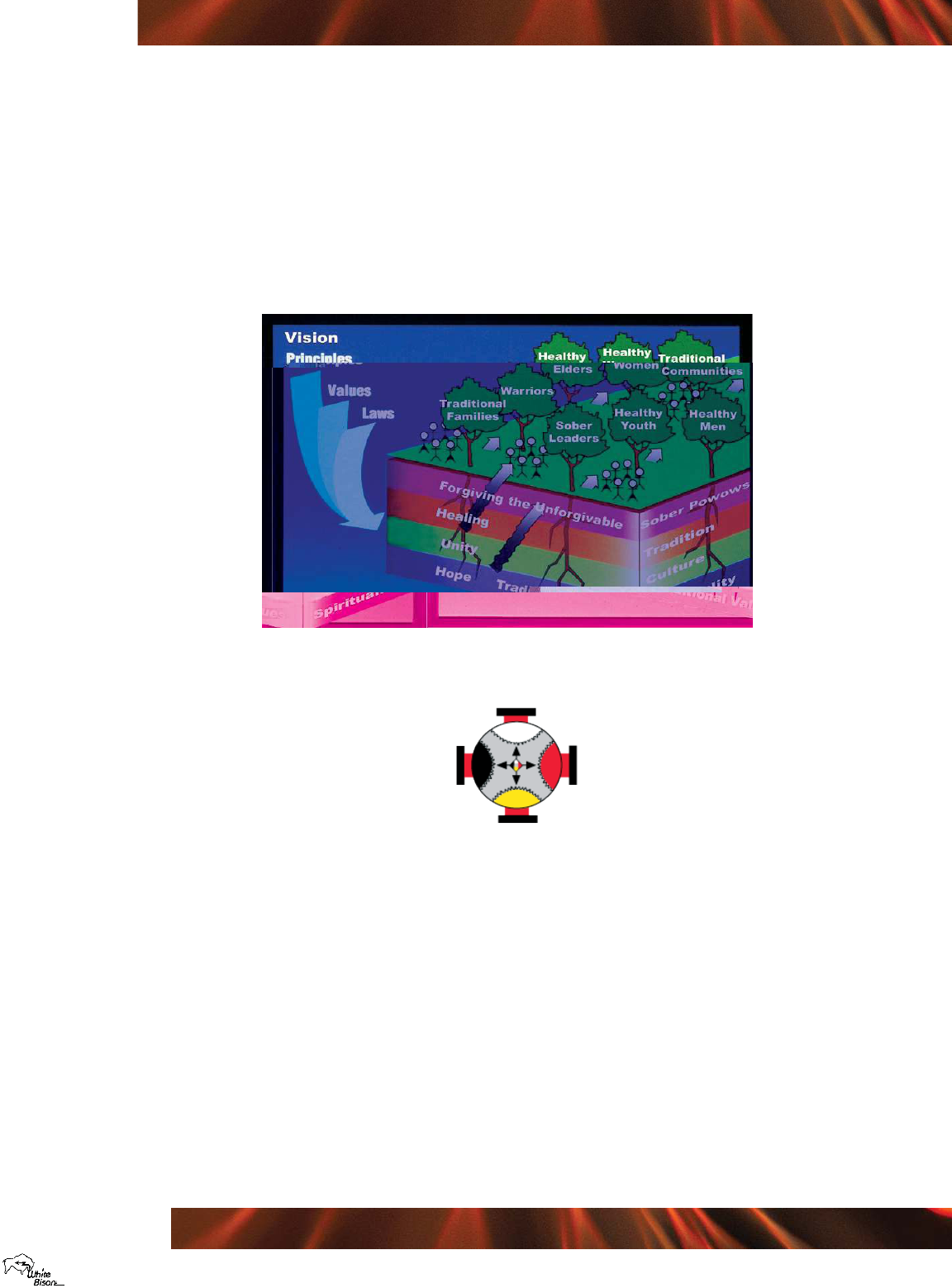
20
Creating healthy thoughts and
feelings completing developmental tasks
The goal of achieving wellness is to replace the anger, guilt, shame and
fear based system with one based upon love. Spirituality and traditional
values provide the guidance. The vision of the healthy family and the
healthy community is based upon principles laws and values.
Recognize what happened to make them unhealthy and what must happen to make them
healthy again.
Acknowledge the secrets, the shame, the hurt feelings, the disappointments, the anger, the
need for new structures and processes, the experience of chaos, conflict and confusion.
Forgive self, others, the unforgivable, the hurts, the sense of loss
Change values, assumptions, beliefs, behaviors, expectations, responses, thinking, feelings
Forgive recognize
change
acknowledge
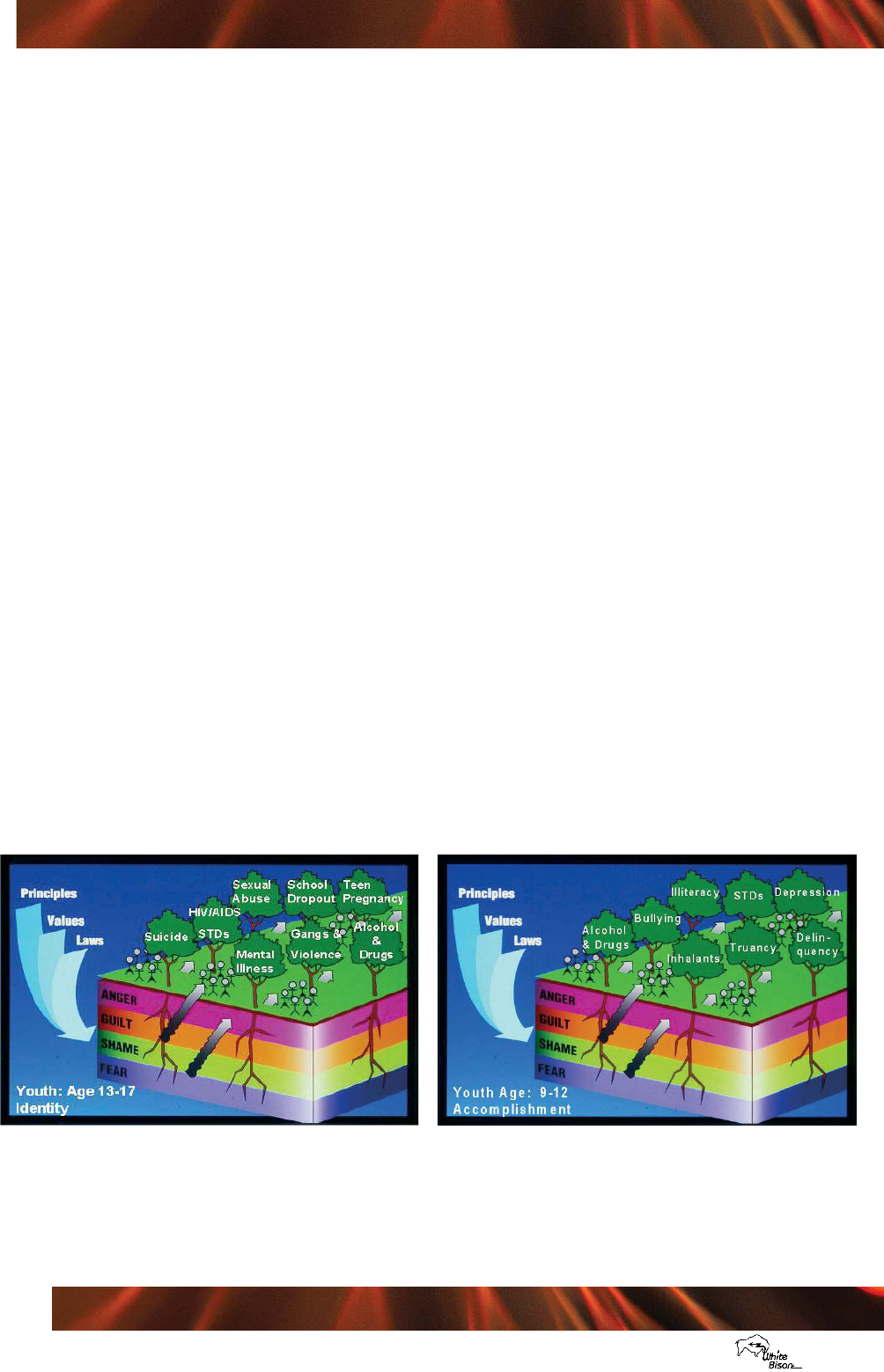
21
Creating healthy thoughts and
feelings completing developmental tasks
Encourage a
Healthy Identity
• Enroll youth in community cultural activities
• Participate with youth in community events
• Encourage service learning projects
• Help with household chores
• Mentor younger children (tutor, coach)
• Encourage participation in multi-generational
activities
• Discuss college plans (set expectations early)
• Listen to youth with eyes and ears
• Invite friends home to dinner
• Encourage skill development (sports, music,
art, crafts)
• Attend school functions with youth
• Know teachers, principal
• Give praise, rewards, recognition
• Many hugs
• Solution focus for conflicts
• Encourage part time work after school
• Participate in cultural and spiritual events
• Attend religious services as a family
• Participate in Family Talking Circle
• Create family traditions
Guide Youth to
Accomplishment
• Encourage goal setting
• Create opportunities to "stretch"
• Encourage caring for other children
• Encourage mentoring other children
• Help older adults and grandparents
• Help with household chores
• Attend religious services with family
• Schedule homework, reading, learning time
• Participate in cultural and spiritual events
• Help with community events
• Create servcie learning opportunities
• Take and interest in child's homework
• Talk about the dangers of drugs, alcohol, sex
• Get to know teachers, principal
• Participate in PTA
• Parents how up where youth hang out
• Give praise, recognition, rewards
• Encourage healthy activities for youth and
their friends
• Encourage daily exercise routines
• Coach youth in making choices and making
plans

22
Creating healthy thoughts and
feelings completing developmental tasks
Helping Children
Develop Initiative
• Encourage exploration
• Cultural and spiritual events
• Help with household tasks & projects
• Coach child
• Set a time to help with school work
• Enroll child in sports, projects
• Help prepare for ceremonies
• Use language skills
• Have child tell stories and sing songs
• Have child set up a schedule
• Have child describe how something will be
• done, step by step
• Encourage projects with several steps
• Give praise; rewards; recognition
• Listen carefully to your child
• Learn dance, drumming
• Observe how your child uses free time
• Continue routines, schedules, boundaries
• Learn about values, compassion
• Participate in family talking circle
Helping Children
Develop
Autonomy
• Set routines and boundaries (when to do what,
what is acceptable when, outings, napping,
assign chores, clothing, eating, )
• Provide opportunities to interact with other
children (day care, Cousins, relatives, friends)
• Provide opportunities to spend time with
grandparents and other Relatives (visits to the
reservation)
• Create a safe environment (child proof,
emotional and physical safety)
• Ensure proper nutrition (food choices
• Lots of Affection and holding; Lots of praise
and acknowledgement
• Anticipate new places, activities, events by
explaining them to child
• Allow child to make mistakes
• Be silly with your child
• Encourage exploration, testing, learning
• Participate in appropriate cultural and spiritual
events
• Use of Native Language when ever possible
• Help child learn new skills, nature,
prayers, outdoor exploring, picnics, colors,
drawing, coloring, painting, playing,
patterns, words, spelling, names, stories,
songs, musical instruments (drums,
flute, piano), running, jumping, dancing,
Set the Stage for
the Development
of Trust
• Avoid alcohol and drugs during pregnancy
• Be sure to include spouse/father in baby’s care
• Learn the childcare customs of your culture
• Parents learn traditional roles of men, women,
relatives (involve
• grandparents, aunts & uncles in child’s life)
• Create a safe environment
• Create a routine (feeding, changing, napping,
outings)
• Ensure proper nutrition
• Lots of affection, holding, reading stories,
songs, music, baby
• “athletics”
• Lots of praise and acknowledgement
• Healthy relationship between parents
• Participate in appropriate cultural and spiritual
events (take baby
• along also)
• Use of Native language when ever possible
• Help baby learn words, phrases, sitting,
crawling, walking, running, playing

23
NOTES
•

24
Checklist to help start your meetings
♦ Make arrangements for the Circle Meetings
♦ Find a convenient location. This could be a room at the community center, at a church, or even
at someone’s home.
♦ If you are going to work with youth at a school, church, shelter, detention center, or community
center, you may want to work out an agreement with those in charge.
♦ Recruit people who have an interest in and invite them to come a meeting.
♦ If you are working with youth, you will need to explain the program to parents to make sure that
they give permission (for Daughters of Tradition and Sons of Tradition, parents/relatives could be a
real asset as helpers and mentors!)
♦ Once you make a commitment to a time and place--SHOW UP & Be Consistent!
♦ The first few meetings you might have to contact people to remind them about the meeting.
Remember building the Circle is about creating relationships.
For each meeting you will need:
■ a coffee pot and coffee (tea, juice or water) and have people alternate in
bringing snacks.
■ a TV/ DVD player or Laptop screen & projector
■ a circle of chairs
■ sage or cedar
■ a Talking Stick or equivalent

25
Lesson Planning
Lesson Date: ______________________
Lesson # : ____
This is a resource to help you in planning the lessons for each week.
The sessions should be around 2 hours.
There are some general things that should always be done:
1) Pray for the people and for yourself (that you will be sensitive to them during the time you spend with them).
Be sure that you review the lesson materials, including the videos, prior to the meeting; the material and
facilitation process should be fresh in your mind.
2) Be sure that the room is set up in a circle and that all of the video equipment is working properly.
And if possible, make sure that refreshments of some kind (even if just coffee or water) is available.
Tissues should also be available!
For each of the following categories, think through the approach you will take and make some notes:
• Introduction: Think about how you will introduce the theme of the lesson, answer any questions,
have participants sign the attendance sheet at this time; then, review the agenda for the day, noting
anything that might be different from last time)
• Opening Ceremony: (What will the focus of the opening ceremony be for this session; who will do it?
It might be that as the participants get more comfortable with this, they can lead it, as appropriate for
your culture.)
• Video: (How does this video provide a framework for the teachings today?....what are the significant
topics for these participants? Be sure to include the time for each of the videos—that time will frame
the rest of the lesson!)
Talking Circle: (Given the topics presented in the videos, how will you introduce the Circle to the
Talking Circle Theme?)
Mind Mapping and other Exercises: (How might you frame to exercises to make sure that the
participants get the most value from them?)
Lessons Learned: (This is actually a short closing circle; have the participants go around the circle
and tell one or two things that they will put into practice right away.)
Closing Prayer (If you lead this, think through what you might emphasize for this particular session.
Or consider how to coach one of the women so that they can take turns leading the closing prayer.
Remember to hold hands.)

26
Information Needed to Complete
the Online Circle Registration Form
Complete this Information for the Registration Form
You can write the information that is needed for the online registration process.
Facilitator Name: (If you are partnering with someone else in your community, please include all
facilitator names)
A. B.
Facilitator Phone Number:
A. ( ____) B.( ____)
Community Meetings are conducted in:
(This could be a tribe, town, community center, etc. We will be putting this information on a
large map to show all the areas where there is a circle. This will be available on our website. )
Particular Emphasis:
(Are you targeting a particular group such as women, men, youth, prisoners, Medicine Wheel and 12
Steps, Mending Broken Hearts, etc.)
Group Meeting Schedule: _____________________________________________
Please include the day and time the meeting will take place.
Name Your Group has chosen: ____________________________________________
This will be displayed on the White Bison Website at www.whitebison.org/fire_list.html.
Group Address:________________________________________________________
City: ___________________________ State:______ Zip: ________________
Group e-mail: ________________________________________________________
Group Availability: Open meeting Closed meeting
(Please indicate whether this group meeting is open or closed to new members.)
Register your circle at www.whitebison.org or send this form to:

27
TRACKING THE CIRCLE
Please help us in keeping track of the progress of your Circle
by completing this form and mailing, faxing or e-mail to the White Bison office
Fax: 1-719-548-9407
Mail: 701 N. 20th Street
Colorado Springs, CO 80904
info@whitebison.org
Today’s Date: ___________________________________
Name of Circle: ______________________________________________________________
Location of Circle: ____________________________________________________________
Address: ___________________________________________________________________
City: ___________________________________________ State: _______ Zip:___________
Name of Contact person: ______________________________________________________
E-mail for Contact person: ______________________________________________________
Phone for Contact person: _____________________________________________________
Beginning Date of Circle: ______________________________________________________
Date the Circle Ended: ___________________________
If the Circle is ongoing, how many sessions have you met? __________________________
Was this Circle: open closed
(open means that anyone could enter at any time; closed means that after the first few sessions,
new people had to wait until a new series started)
Number of people who regularly attended (approximate): ____________________
Number of people who completed the entire series: ________________________
Number who started their own groups after completing the series: ____________
What was your experience like as a facilitator?
What did people tell you about their experience with the materials?
Remember building the Circle is about creating relationships.

28
Attendance Roster
Please write in the name of each participant and check each session that is attended.
Name 1 2 3 4 5 6 7 8 9 10 11 12 13 14 15 16 17 18

29
Registrants Contact Information
Date Session Began: _____________
.
Name Phone E-mail
Married;Widowed;
Single; Divorced;
Domestic Partner Tribal Affiliation

30
Pre Program Survey
(Pre-surveys are completed the first or second week that the Circle is in session for a new person. The post-
survey is completed when participants have completed the entire series. The same form is used for both).
Please mail, fax or e-mail the following forms to the White Bison office.
You may save a copy for your records. These forms will help us to track outcomes and success of our
programs and is very helpful for the sustainability of White Bison.
Fax: 1-719-548-9407
Mail: 701 N. 20th Street
Colorado Springs, CO 80904
info@whitebison.org
Today's Date:
Focus of this Circle:
Name (use only first name and initial):
(we need to have a way to match the pre test with the post test--so you can choose a “handle”
if you wish)
How many sessions have you attended as of today?
Please circle the response for each of the following questions:
1. Rate your experience with doing Program work in the past:
5 4 3 2 1
excellent good okay uncomfortable awful
(lifechanging) (interesting) (one more resource) (conflicts with my values) (felt out of place)
2. Rate your experience with mutual support groups:
5 4 3 2 1
excellent good okay uncomfortable awful
(lifechanging) (interesting) (one more resource) (conflicts with my values) (felt out of place)
3. Rate your current participation in spiritual practices
(i.e. prayer, religious services, sweatlodge, sundance)
5 4 3 2 1
Daily weekly occasionally very seldom never
4. Rate your current use of traditional Native American teachings for healthy and sober living:
5 4 3 2 1
Daily weekly occasionally very seldom never

31
Pre Program Survey (continued)
5.Rate your current comfort level with your family (i.e. parents, siblings, foster parents, grandparents,
aunties):
5 4 3 2 1
excellent good okay uncomfortable awful
6. Rate your current comfort level with personal relationships: (i.e. spouse; life partner)
5 4 3 2 1
excellent good okay uncomfortable awful
7. Rate your comfort level with making healthy choices (i.e. choosing sobriety):
5 4 3 2 1
excellent good okay uncomfortable awful
8. Rate your comfort level with helping others in their Wellbriety journey:
5 4 3 2 1
excellent good okay uncomfortable don’t ask me to do this
9. Rate your level of trust in other people.
5 4 3 2 1
excellent most of the time sometimes not often not at all
10. Rate your level of knowledge about your own culture.
5 4 3 2 1

32
POST Program Survey
(Pre-surveys are completed the first or second week that the Circle is in session for a new person. The post-
survey is completed when participants have completed the entire series. The same form is used for both).
Please mail, fax or e-mail the following forms to the White Bison office.
You may save a copy for your records. These forms will help us to track outcomes and success of our
programs and is very helpful for the sustainability of White Bison.
Fax: 1-719-548-9407
Mail: 701 N. 20th Street
Colorado Springs, CO 80904
info@whitebison.org
Today's Date:
Focus of this Circle:
Name (use only first name and initial):
(we need to have a way to match the pre test with the post test--so you can choose a “handle”
if you wish)
How many sessions have you attended as of today?
Please circle the response for each of the following questions:
1. Rate your experience with doing Program work in the past:
5 4 3 2 1
excellent good okay uncomfortable awful
(lifechanging) (interesting) (one more resource) (conflicts with my values) (felt out of place)
2. Rate your experience with mutual support groups:
5 4 3 2 1
excellent good okay uncomfortable awful
(lifechanging) (interesting) (one more resource) (conflicts with my values) (felt out of place)
3. Rate your current participation in spiritual practices
(i.e. prayer, religious services, sweatlodge, sundance)
5 4 3 2 1
Daily weekly occasionally very seldom never
4. Rate your current use of traditional Native American teachings for healthy and sober living:
5 4 3 2 1
Daily weekly occasionally very seldom never

33
POST Program Survey (continued)
5.Rate your current comfort level with your family (i.e. parents, siblings, foster parents, grandparents,
aunties):
5 4 3 2 1
excellent good okay uncomfortable awful
6. Rate your current comfort level with personal relationships: (i.e. spouse; life partner)
5 4 3 2 1
excellent good okay uncomfortable awful
7. Rate your comfort level with making healthy choices (i.e. choosing sobriety):
5 4 3 2 1
excellent good okay uncomfortable awful
8. Rate your comfort level with helping others in their Wellbriety journey:
5 4 3 2 1
excellent good okay uncomfortable don’t ask me to do this
9. Rate your level of trust in other people.
5 4 3 2 1
excellent most of the time sometimes not often not at all
10. Rate your level of knowledge about your own culture.
5 4 3 2 1

34
Program Completion Analysis
Today’s Date: _______ Name _______________________ Location: ____________
Biographical Data:
A. Were you ever in prison/jail? ___________
B. What were you convicted of? ___________________
C. Have you been on Parole before? _____ How many times? _______
Were you successful? _______
D. Were you ever in treatment? ____________
E. What is your date of birth? __/__/__ (month/day/year)
F. What is your occupation? ______________________
G. What is your tribal affiliation? __________________
H. What is the highest grade (including college) you completed? ___________________
I. When was the last time you held a full time job? ______________________________
J. Please check your marital status:
__married __separated __divorced __widowed __partner (living with someone)
K. How many children do you have? _______
L. What are their ages? _______________________________________________
M. How often do you see them?
__ every day __weekly ___monthly __every so often __once or twice a year __ never

35
Survey Questions:
1. Have you ever been involved in a Wellbriety program? Yes: _______ No: _________
2. Do you consider yourself to be in recovery? ____yes ___no
If yes, what is your recovery “date?” ______________
3. Which program are you currently attending?
Name of Group ___________________ Location ___________________________
a.) What trainings have you participated in since you have been participating? (Please check each
one).
__MW12 Steps - Adults when: __/__/____ __Mending Broken Hearts when __/__/____
__MW12 Steps - Youth when: __/__/____ __Mending Broken Hearts-Youth __/__/____
__Families of Tradition when: __/__/____ __ Understanding the Purpose __/__/____
__Fathers of Tradition when: __/__/___ __ Sons of Tradition when __/__/____
__Mothers of Traditon when: __/__/____ __Daughters of Tradition I & II __/__/____
b.) What was important to you about participating in these trainings?
c.) What suggestions would you have for other trainings?
4. Employment:
a.) Did you have a job when you entered the Wellbriety program?____yes ___no
If yes, what job were you doing? _________________________________
If no, did your participation in the Wellbriety program lead to you finding a job? ____yes ___
no
b.) Were the Wellbriety team members helpful for you in finding and/or keeping your job? ____yes
___no
If yes, please describe in what way they were helpful.
If no, please explain.
5. Services:
a.) What recovery support services connected with the Wellbriety programs have you used or
participated in?
√
Activity/Service
√
Activity/Service
√
Activity/Service
Rides to
meetings
Help creating
a supportive
network
Help finding
a job

36
√
Activity/Service
√
Activity/Service
√
Activity/Service
Referral to
Elders/spiritual
advisors
Help with
family
resources
Help getting
into school
Help with
recovery plan
Help with
children’s
resources
Help finding a
place to live
Help getting
driver’s
license,
insurance,
identification
Assist with
relapse
prevention
Referral to
mental health
services
Referral Sweat
lodge
Finding a
sponsor
Referral
to family
counseling
services
Referral to
family services
resources
Talking Circles Wellbriety
Recovery
Coach
Referral to
religious
services
Participate in
Drum Group
Other:
6. Spirituality:
a. ) Have you connected with a spiritual advisor as a result of your participation in this program?
____yes ___no___don’t know
b.) If yes, what are the qualities about this person that makes his/her assistance valuable to you?
c.) If no, please explain ( Are you looking for a special spiritual advisor? Do you need help finding
this person? Do you not wish to have one?)
d.) Please identify the type of spiritual practices that you include in your life.
e.) To what extent has this program helped you to reconnect with your spirituality? Check the word
that applies)
5 4 3 2 1
________________________________________________________________________
__greatly __very much __somewhat __not so much __not at all
f. Explain

37
7.Relationships:
a.) To what extent have your relationships (with spouse, partner) have improved as a result of your
participation in this program? (check the word that applies)
5 4 3 2 1
________________________________________________________________________
__greatly __very much __somewhat __not so much __not at all
b.)Explain
c.) To what extent has your relationship with your children has improved as a result of your
participation in this program? (check the word that applies)
5 4 3 2 1
________________________________________________________________________
__greatly __very much __somewhat __not so much __not at all
d.) Explain
e.) To what extent has your relationship with your extended family has improved as a result of your
participation in this program? (check the word that applies)
5 4 3 2 1
________________________________________________________________________
__greatly __very much __somewhat __not so much __not at all
f.) Explain
g.). To what extent has this program helped you to reconnect with your family? (check the word that
applies)
5 4 3 2 1
________________________________________________________________________
__greatly __very much __somewhat __not so much __not at all
h.) Explain

38
8.Community:
a.) To what extent has this program helped you to reconnect with your community? (check the word
that applies)
5 4 3 2 1
________________________________________________________________________
__greatly __very much __somewhat __not so much __not at all
b.) In what way have you reconnected?
c.) What would you tell others about the importance of community?
9.Culture:
To what extent has this program helped you to reconnect with your culture? (check the word that
applies)
5 4 3 2 1
________________________________________________________________________
__greatly __very much __somewhat __not so much __not at all
b.) In what way have you reconnected to your culture?
c.) Please describe which aspects of your culture are important to you now.
.10. Personal Growth:
a.) To what extent has this program helped you to reconnect with your personal character? (check the
word that applies)
5 4 3 2 1
________________________________________________________________________
__greatly __very much __somewhat __not so much __not at all
b.) Please describe one or two aspects ofyour character that have changed for the better.
11. If you were to tell someone about your experience in this program, what would you say?

39
12. In what way has this program been specifically helpful to you?
13. What might make it more helpful?
14. What would your family (i.e. spouse, children, parents) say about your participation in this
program?
15. What would your probation/parole officer say about you since you have been participating in this
program?
16. What volunteer activities are you doing to “give back?”
17. What activities have your family members participated in through the program you are involved
in?

40
18. In what way has this program had an impact on your ability to continue your recovery journey?
19. In what ways has this program helped you to avoid re-offending ( if applicable)
20. What plans do you have for your life?

41
(Read the story at http://www.whitebison.org/wellbriety-journey/NewsStories.htm).
White Bison Mission
We are a Native American operated 501 (c)
3 nonprofit corporation dedicated to creating
and sustaining a grassroots Wellbriety
Movement that provides culturally based
healing to the next seven generations of
Indigenous People.
The Wellbriety
Movement Mission
A sustainable grassroots Wellbriety
Movement that provides culturally based
healing to the next seven generations of
indigenous people.
Wellbriety Training
Institute Mission
We are an internationally acclaimed,
Native American operated training institute
and center of excellence providing culturally
based training for professionals and
grassroots activists who work directly with
individuals, families and communities.
In support of the Wellbriety Movement
and those focused on the healing of the next
seven generations of indigenous people, we
will constantly strive to provide increasingly
higher quality and more easy to implement
Wellbriety training programs.
National Gatherings
• 1994: Gathering of the Elders
(Janesville, WI) Dedication of the
Sacred Hoop
• 1995: Women’s Leadership
Gathering (Denver, CO)
• 1996: Men’s Gathering (Florissant,
CO)
• 2012 Women in Wellbriety
Sacred Hoop
Journeys
(Video documentaries -- www.
coyhisconsulting.org)
• 1999: Healing the Nations: Visits to
32 Tribal Colleges
• 2000: Wiping of the Tears (3800
mile walk from Los Angeles to
Washington DC)
• 2002: Healing Native Women and
Children (19 urban and reservation
communities West of the Mississippi)
• 2003 Healing Native Men and
Children (17 urban and reservation
communities East of the Mississippi)
• 2006: Sacred Hoop Journey to Sitka,
Alaska, to support the raising of the
Wellbriety Totem Pole
• 2007: Sacred Hoop Journey to
Montana--13 stops (tribes and
prisons)
• 2008: Sacred Hoop Journey to
Minnesota-- 9 stops tribes and
prisons
• 2009: The Way Home Tour--
Forgiving the Unforgivable Legacy of
the Boarding Schools
Principles
• The circle is sacred. It was given to us
by the Creator. This is one of Creators
many gifts which we are to use
according to Creator's instructions.
• 2011: Journey to Forgiveness -
Documentary
Wellbriety
Conferences
• 1999: Strengthening Individuals
(Colorado Springs, CO)
• 2001: Strengthening our Families
(Rapid City, SD)
• 2002: Strengthening our
Communities (Billings, MT)
• 2003: Strengthening our Nations
(Albuquerque, NM)
• 2005: Healing the Hurts: The
Grassroots Speaks (Denver, CO)
• 2006: Taking a Stand Against Meth:
Recovery is Possible (Denver, CO)
• 2006: Wellbriety in Motion--Youth,
Families and Suicide Prevention
(Denver, CO)
• 2008: Healing the Hurts, Youth and
Families Speak--Intergenerational
Trauma (Minneapolis)
• 2013: Intergenerational Healing
for Families - Celebrate NANACoA
Denver, CO
Wellbriety
Initiatives
• 2002: Wellbriety for Youth
(prevention and leadership
development for Native American
youth)
• 2002: Wellbriety for Prisons (a
recovery support system for those
returning from prison)
• 2005: 100 Drums -- Communities in
Healing
• 2007: Fatherhood Initiative
• 2007: Wellbriety Indian Center of
Colorado Springs
• 2008: Wellbriety Leadership
Training Institute
• 2012: Wellbriety Advocacy Office
-Washington, DC
Wellbriety
Principles
• Four Laws of Change and the Healing
Forest
• Teachings of the Medicine Wheel
(Circle Teachings)
• Innate Learning
• Cycle of Life
WELLBRIETY MOVEMENT
MILESTONES AND RESOURCES

42
(Read the story at http://www.whitebison.org/wellbriety-journey/NewsStories.htm).
Wellbriety
Trainings,
Books and
Curriculum
• 1990: Natural Path
to Growth (personal
development program)
• 1993: Meditations with the
Native American Elders by
Don Coyhis
• 1993: The Healing Forest
Program (culturally based
community development
program)
• 1998: Medicine Wheel
and 12 Steps for Men and
for Women (videos and
workbooks are provided)
• 1999: Firestarter
Certification Training
(Peers helping peers in
recovery)
• 1999: Understanding
Native American Culture:
Insights for Recovery
Professionals by Don
Coyhis
• 2000: Wellbriety!
Online Magazine (www.
whitebison.org)
• 2000: Daughters of
Tradition: Prevention
Curriculum for Girls age
8-12
• 2002: Sons of Tradition:
Character Building and
Prevention Curriculum for
Boys age 13-17
• 2002: Medicine Wheel
and 12 Steps for Friends
and Families & Adult
Children of Alcoholics
2002: Red Road to
Wellbriety: In the Native
American Way
• 2003: Families of
Tradition: A Recovery
Support Curriculum
for families that have
experienced substance
abuse
• 2003: Seven Steps to
Systemic Community
Change
• 2004: Daughters of
Tradition II: Character
Building and Prevention
Education for Girls age
13-17
• 2004: 7 Trainings: A
strategy for delivering
the Grassroots Wellbriety
Curriculum in a 3-day
conference format
• 2004: The Positive
Warrior: Native American
Approach for Therapeutic
Communities in Prison
Settings
• 2004: Coalitions using
Clan Knowledge: Creating
Coalitions thru Storytelling
• 2005: Warrior Down:
Families in Recovery
• 2005: Warrior Down:
A Relapse Prevention
Support Program for
Native Americans
• 2005: Warrior Down:
Youth Suicide Prevention
Program
• 2006: Alcohol Problems
in Native America: The
Untold Story of Resistance
and Recovery:
• The Truth about the Lie
by Don L. Coyhis and
William White
• 2007: Fathers
of Tradition: An
Intergenerational
Parenting Approach
• 2007: Medicine Wheel
and 12 Steps for
Adolescent Boys and Girls
• 2007: Meditations with
Native American Elders -
The Four Season by
Don L. Coyhis
• 2008: Understanding
the Purpose of Life: 12
Teachings for Native
Youth by Don L. Coyhis
• 2009: Understanding
Native American Culture
2nd. Ed. by Don L. Coyhis
• 2010 Mothers of Tradition
Training Curriculum
• 2011: Wellbriety
Movement Comes of Age
by Don L. Coyhis
• 2012:Mending Broken
Hearts Curriculum
• 2013: Mending Broken
Hearts for Youth
Curriculum
WELLBRIETY MOVEMENT
MILESTONES AND RESOURCES, Cont.
Websites/Social
Media Links
www.whitebison.org
www.wellbrietytraining.com
www.wellbriety.com
www.wellbrietyconferences.com
www.coyhispublishing.com
Facebook
White Bison, Inc.
Wellbriety Technical
Assistance Center
Twitter
@Wellbriety

43
WELLBRIETY TRAINING PROGRAMS
MEDICINE WHEEL AND 12 STEPS - MEN
Purpose: The Medicine Wheel and 12 Step program was developed to provide a culturally
appropriate 12 Step program for Native American people. This program was developed by
White Bison, based upon Teachings of the Medicine Wheel, the Cycle of Life and the Four
Laws of Change.
MEDICINE WHEEL AND 12 STEPS - WOMEN
Purpose: The Medicine Wheel and 12 Step program was developed to provide a culturally
appropriate 12 Step program for Native American people. This program was developed by
White Bison, based upon Teachings of the Medicine Wheel, the Cycle of Life and the Four
Laws of Change.
MEDICINE WHEEL AND 12 STEPS - YOUTH
Purpose: Given the different concerns that boys and girls have, separate programs have
been developed for each. Medicine Wheel and 12 Steps for youth is specifically designed
for youth (age 13-21). The focus of the program is to get behind the symptoms of alcohol
and drug misuse and focus on the emotional, mental, physical, and spiritual foundations
that cause young people to begin using alcohol and drugs in the first place.
MENDING BROKEN HEARTS
Purpose: Develop the capacity of the community to heal from unresolved grief and the
losses created by the legacy of Historical and Intergenerational Trauma, especially the effects
of the Boarding School era.
MENDING BROKEN HEARTS - YOUTH
Purpose: Develop the capacity in our Youth to build healthy communities by helping
them recogonize, acknwledge, forgive and change to help them to heal from unresolved
grief created by Historical and Intergenerational Trauma-direct effects of the Boarding
School Era.
uNDERSTANDING THE PURPOSE TO LIFE
Purpose: The Elders’ wisdom forms the basis for this program. All living beings have a
purpose. Young people are warriors-in-training. Our communities form a Forest. When all
the “trees” in the forest are healthy, we are living in a Healing Forest.
Fathers of tradition
Purpose: Fathers of Tradition is a culturally oriented educational program that develops the
fathering skills of Native American men. This is a cognitive, behavioral and spiritual program.
Life skills are embedded in each of the sessions. Ceremonial activities such as sweat lodge
and smudging, drumming and singing may be included as part of the local cultural practices.
Teachings of the Elders provide the foundation for the curriculum. Specific processes include
talking circles, mind mapping, mentoring, experiential learning, traditional story telling,
cultural practices and service learning make up the core elements of the curriculum.
mothers of tradition
Purpose: Develop the skills and knowledge to live a healthy life as a traditional, spiritual
Native American woman. Increase awareness of how intergenerational trauma interrupted
the culture, language, family ties, and parenting practices among Native people. Learn how to
apply the cultural teachings to bring healing to children, relationships and community.
